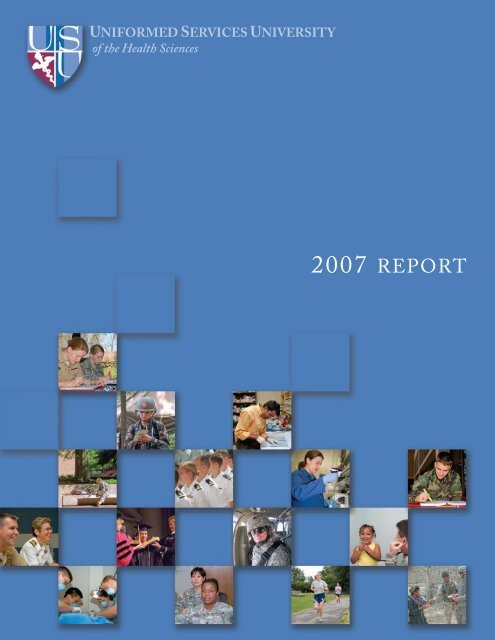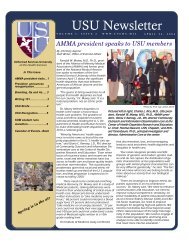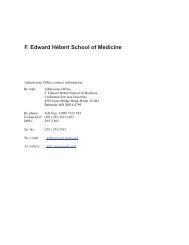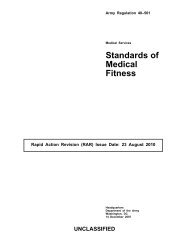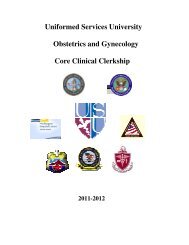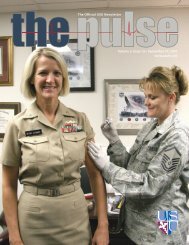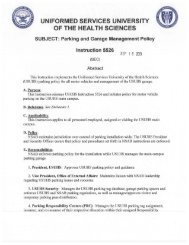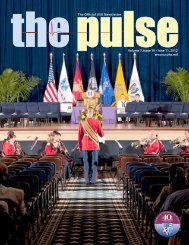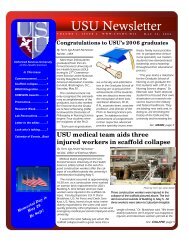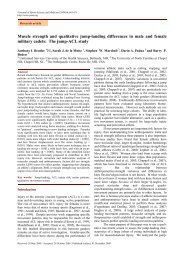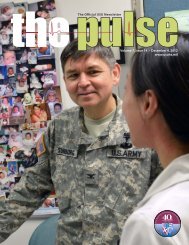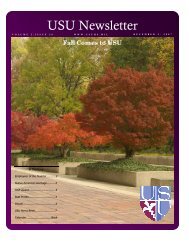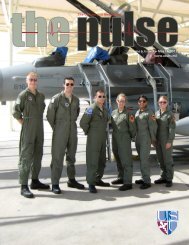Annual Report - Uniformed Services University of the Health Sciences
Annual Report - Uniformed Services University of the Health Sciences
Annual Report - Uniformed Services University of the Health Sciences
You also want an ePaper? Increase the reach of your titles
YUMPU automatically turns print PDFs into web optimized ePapers that Google loves.
UNIFORMED SERVICES UNIVERSITY<strong>of</strong> <strong>the</strong> <strong>Health</strong> <strong>Sciences</strong>2007 REPORT
President’s LetterThis has been an extraordinary and challenging year as <strong>the</strong> nation struggles tocome to terms with <strong>the</strong> costs <strong>of</strong> war, and we strive to care for <strong>the</strong> wounded and <strong>the</strong>irfamilies. USU faculty, staff and students are deeply engaged in developing <strong>the</strong> skills,technologies and knowledge necessary to provide <strong>the</strong> best possible care for thosein harm’s way. It is our job to educate those who protect <strong>the</strong> health <strong>of</strong> our soldiers,sailors, airmen and Marines; to fur<strong>the</strong>r military medical research; and to ensure tha<strong>the</strong>alth care practitioners are equipped to deal with <strong>the</strong> unique challenges <strong>of</strong> militarymedicine and public health.USU continues to distinguish itself as a center <strong>of</strong> excellence in both education and research. Our faculty perform not only asleaders in <strong>the</strong> military health system, but also in academic medicine. In 2007, <strong>the</strong> Certified Nurse Anes<strong>the</strong>tist program in ourGraduate School <strong>of</strong> Nursing was ranked sixth in <strong>the</strong> nation out <strong>of</strong> 106 programs by U.S. News and World <strong>Report</strong>. Dr. GerryQuinnan and Dr. Christopher Broder published an important piece on HIV/AIDS in <strong>the</strong> Proceedings <strong>of</strong> <strong>the</strong> National Academy<strong>of</strong> <strong>Sciences</strong>. Dr. D. Scott Merrell presented groundbreaking work on Helicobacter pylori. The Center for Traumatic Stress, led byDr. Robert Ursano, had several projects that set <strong>the</strong> standard <strong>of</strong> care for those affected by Post Traumatic Stress Disorder (PTSD).We are particularly proud <strong>of</strong> Alison O’Brien, Ph.D., Chair <strong>of</strong> <strong>the</strong> Department <strong>of</strong> Microbiology, who was elected by her peers tobe President <strong>of</strong> <strong>the</strong> American Society for Microbiology, <strong>the</strong> world’s largest scientific society. Additionally, research undertakenby our faculty continues to produce important breakthroughs in areas including emerging infectious diseases, epilepsy researchand neuroscience.Our world-class education and training programs have continued to grow in response to <strong>the</strong> needs <strong>of</strong> our deployed troopsand <strong>the</strong>ir families. The university launched an ambitious new program designed to address mental health care needs. In its firstyear <strong>of</strong> operation, <strong>the</strong> Center for Deployment Psychology trained more than 500 psychologists and social workers to providesuperior mental health care to military personnel and <strong>the</strong>ir families.USU continues to play a significant role in shaping our nation’s health care. Our alumni hold key positions in <strong>the</strong> militaryand public health systems, from commands at major military medical centers to leadership positions at <strong>the</strong> Food and DrugAdministration. Many are directing medical teams and providing critical care and rehabilitation services for our nation’s soldiers,sailors, airmen and Marines deployed to Iraq and Afghanistan at Landstuhl Regional Medical Center, Walter Reed ArmyMedical Center, <strong>the</strong> National Naval Medical Center and o<strong>the</strong>r locations central to medical care in <strong>the</strong> current conflict.In this report, we have focused on some <strong>of</strong> <strong>the</strong> many USU students, faculty and staff who share a distinctive commitment toservice. Whe<strong>the</strong>r <strong>the</strong>y come from a military career, from <strong>the</strong> service academies or from o<strong>the</strong>r parts <strong>of</strong> government, academic orprivate sectors, USU personnel embody <strong>the</strong> ideals <strong>of</strong> service to o<strong>the</strong>rs and to <strong>the</strong> nation.Charles L. Rice, M.D.
A HISTORY OF SUCCESSThe American military medical community has produced significant research and clinical advancesthrough <strong>the</strong> years. The First World War saw <strong>the</strong> massive application <strong>of</strong> modern medicine includingimmunization, advanced surgery, use <strong>of</strong> motor ambulances, management <strong>of</strong> shock and treatment<strong>of</strong> psychiatric disorders. World War II brought widespread use <strong>of</strong> penicillin, mobile hospitals andextensive use <strong>of</strong> military medics on <strong>the</strong> front lines.Today, military medicine continues to lead <strong>the</strong> way in research and clinical care. The <strong>Uniformed</strong><strong>Services</strong> <strong>University</strong> <strong>of</strong> <strong>the</strong> <strong>Health</strong> <strong>Sciences</strong> (USU) plays a pivotal role in conducting military medicalresearch, and providing consultation and education programs that help <strong>the</strong> country face <strong>the</strong> manychallenges <strong>of</strong> a nation at war.The university is engaged in a wide array <strong>of</strong> research and training in areas such as traumatic brain injury(TBI), Post Traumatic Stress Disorder (PTSD), emerging infectious diseases and supporting <strong>the</strong> continuum<strong>of</strong> care from battlefield through rehabilitation to return to <strong>the</strong> workforce.“WEST POINT” OF MILITARY MEDICINEAt <strong>the</strong> end <strong>of</strong> World War II, <strong>the</strong> United Statesmilitary discharged more than 10 million menand women. Among those who left service werethousands <strong>of</strong> physicians who returned to civilianpractice. Years later, recognizing <strong>the</strong> urgent needfor career military physicians, Congressman F.Edward Hébert (D-LA) introduced legislation toestablish a “West Point for doctors”— a universityoperated by <strong>the</strong> Department <strong>of</strong> Defense (DoD) t<strong>of</strong>oster a strong military medical system.USU was established by Congress in 1972.The university’s curriculum is similar to that <strong>of</strong> itscivilian counterparts, but it also provides additionalspecialized educational elements geared towardsproducing career uniformed <strong>of</strong>ficers.PREPARING FOR THE FUTUREThe university educates and trains essential healthcare providers to face today’s challenges, and it isdeeply committed to <strong>the</strong> future <strong>of</strong> military medicine.Congress’ approval <strong>of</strong> <strong>the</strong> 2005 recommendationsToday, one in four active-duty physicians are USUalumni. <strong>University</strong> graduates serve in key capacities,including significant leadership positions,critical to <strong>the</strong> successful operation <strong>of</strong> <strong>the</strong> militarymedical and public health systems. Among <strong>the</strong>roles in which alumni have distinguished <strong>the</strong>mselvesare as members <strong>of</strong> <strong>the</strong> White House Presidentialmedical detail, heading terrorism and disasteremergency preparedness and response teamsand providing care and medical leadership duringoverseas military operations. USU’s relevance isconsiderable, more so today than at any point inits history. In a rapidly changing world, universitygraduates are shaping <strong>the</strong> future <strong>of</strong> military andpublic health.<strong>of</strong> <strong>the</strong> Base Realignment and Closure committeepaves <strong>the</strong> way for <strong>the</strong> university’s future as astate-<strong>of</strong>-<strong>the</strong>-art academic health center. CombiningWalter Reed Army Medical Center and <strong>the</strong>National Naval Medical Center —with USU at itsacademic core—<strong>the</strong> Walter Reed National MilitaryMedical Center will create a world-class academichealth system that <strong>of</strong>fers <strong>the</strong> highest quality care,distinguished health education and exemplarybasic and applied research.“While approximately one quarter <strong>of</strong> all new physiciansentering <strong>the</strong> military today are USU alumni, <strong>the</strong>y have adisproportionate impact on military leadership by dint<strong>of</strong> <strong>the</strong>ir specialized training and preparation as leaders.”S. Ward Casscells, III, M.D.,Assistant Secretary <strong>of</strong> Defense for <strong>Health</strong> Affairs (pictured center)2
1777The ContinentalArmy is immunizedagainst smallpoxper General GeorgeWashington’sorders.War <strong>of</strong> 1812 (1812-1815)Dr. James Tilton, PhysicianGeneral, advocates small,dispersed hospitals withgood ventilation, whichimproves <strong>the</strong> health <strong>of</strong>soldiers.1833William Beaumontpublishes his classic workon <strong>the</strong> physiology <strong>of</strong>digestion, which eventuallybecomes <strong>the</strong> cornerstone <strong>of</strong>modern gastroenterology.Civil War (1861-1865)Jonathan Letterman, MedicalDirector, Army <strong>of</strong> <strong>the</strong> Potomac,creates <strong>the</strong> echeloned system <strong>of</strong>patient evacuation and care,which remains <strong>the</strong> basis <strong>of</strong> civilianand military casualty careworldwide.1899The New Worldhookworm, a significantcause <strong>of</strong> anemia in PuertoRico, is discovered,leading to a significantreduction in hookwormdisease.1900The mosquito isidentified as <strong>the</strong> yellowfever vector.1904-1914Yellow fever iscontrolled in <strong>the</strong>Panama Canal Zone,making construction <strong>of</strong><strong>the</strong> canal possible.1909An effectivetyphoidimmunization isdeveloped.1910An anhydrouschlorine methodto purify drinkingwater isintroduced and<strong>the</strong> technology isused worldwide.World War I (1914-1918)A variety <strong>of</strong> medicaltechniques to improve soldiers’survival rates are developed,including wound treatment,blood transfusions, reconstructivesurgery and physical<strong>the</strong>rapy.World War II (1939-1945)Major medical developments include <strong>the</strong>prevalent use <strong>of</strong> penicillin, widespread use<strong>of</strong> mobile hospitals to support troops closeto <strong>the</strong> front lines, aero-medical evacuationto ensure speedier medical care andextensive use <strong>of</strong> military medics on <strong>the</strong>front lines.1944Hepatitis A and Bare differentiatedand gammaglobulin treatmentsare established.1947Scrub typhus transmissionproblems areresolved and chloraphenicoltreatmentintroduced.Korean War (1950-1953)The Mobile Army Surgical Hospital(MASH) is introduced. Hospital shipsequipped with helicopter landing pads areintroduced as a method for quick-responsemedical attention, changing <strong>the</strong> ships’ rolesfrom medical transports to floatinghospitals.1957The vaccine strain forinfluenza A virus isisolated.1958The cholera oralrehydration regimen isimplemented,dramatically reducingmortality.1960An attenuated vaccineagainst VenezuelanEquine Encephalitis isdeveloped.1961The Tri-Service ArmedForces RadiobiologyResearch Laboratory isestablished.1962Rubella virus is isolatedat <strong>the</strong> Walter ReedArmy Institute <strong>of</strong>Research.1965Antibacterial cream totreat patients wi<strong>the</strong>xtensive burns isdeveloped.1967An oral adenovirusvaccine, which safelyprovides immunity inone dose, is developed.1970A polysaccharidevaccine against groupC meningococci isdeveloped.1972The <strong>Uniformed</strong> <strong>Services</strong><strong>University</strong> <strong>of</strong> <strong>the</strong> <strong>Health</strong><strong>Sciences</strong> (USU) isestablished inBe<strong>the</strong>sda, Maryland.
SCHOOL OF MEDICINEUSU’s F. Edward Hébert School <strong>of</strong> Medicine (SOM) is a traditional medical school with a curriculumenhanced by specialized education, training and research that prepares graduates to provide leadingedgemedical care in even <strong>the</strong> most challenging environments. A primary mission <strong>of</strong> military medicineis keeping troops healthy, so a core educational focus is on health promotion and disease prevention.USU attracts a diverse array <strong>of</strong> students from all over <strong>the</strong> country, each <strong>of</strong> whom has something special incommon—<strong>the</strong>y are among <strong>the</strong> leaders <strong>of</strong> <strong>the</strong>ir generation, dedicated to serving <strong>the</strong> nation through careersin <strong>the</strong> DoD or Public <strong>Health</strong> Service.Unique EDUCATIONThe SOM’s curriculum is designed to educatestudents to provide outstanding care in even <strong>the</strong> mostextreme settings—to practice good medicine in challengingenvironments. The unique four-year programis year-round and is roughly 700 hours longerthan that <strong>of</strong> o<strong>the</strong>r medical schools. This additionaleducation largely focuses on epidemiology, healthpromotion, leadership and field exercises, diseaseprevention and tropical medicine.The uniformed services <strong>of</strong>fer <strong>the</strong> same specialtyoptions enjoyed by students at civilian schools,as well as unique opportunities in areas includingpreventive and public health medicine. Additionally,concentrations are available in service-uniquepractice areas, such as aerospace medicine,undersea medicine, global infectious diseases anddisaster medicine.A military-trained cadre <strong>of</strong> physicians is crucial to ourcountry’s security and well being. SOM graduatessupport national health and preparedness in manyways, from providing expert medical attentionon <strong>the</strong> front lines to caring for service membersand <strong>the</strong>ir families at medical centers at home andabroad. O<strong>the</strong>rs are called upon to act as “medicalambassadors,” sharing knowledge to help o<strong>the</strong>rcountries enhance <strong>the</strong>ir health care infrastructuresand services. The U.S. Public <strong>Health</strong> Service alsovalues this training because it enables graduatesto manage medical operations in both military andcivilian settings.Sunny Ramchandani, M.D., is an internistand an Assistant Pr<strong>of</strong>essor in <strong>the</strong> Department<strong>of</strong> Internal Medicine. Academically first inhis class at <strong>the</strong> U.S. Naval Academy anda graduate <strong>of</strong> both <strong>the</strong> Harvard <strong>University</strong>School <strong>of</strong> Public <strong>Health</strong> and Yale <strong>University</strong>School <strong>of</strong> Medicine, Ramchandani is quicklydistinguishing himself as a researcher, clinicianand teacher.Dr. Ramchandani recently published apaper with colleagues at Johns Hopkins<strong>University</strong> that was subsequently used by <strong>the</strong>government <strong>of</strong> India to enhance anti-retroviral<strong>the</strong>rapy delivery. In 2007, he also traveledto Afghanistan with USU’s Center for Disaster and HumanitarianAssistance Medicine as part <strong>of</strong> <strong>the</strong>ir initiative to help streng<strong>the</strong>n itshealth care infrastructure.“USU is <strong>the</strong> central resourcefor academic military medicine.If we’re out in <strong>the</strong> fieldconducting research, if wewant to pursue new areas <strong>of</strong>investigation, if we want toenhance training or changecurricula based on real-worldexperience…no matter whatwe need, <strong>the</strong> university is<strong>the</strong> first place we connectwith… The synergy that USUshares with <strong>the</strong> U.S. militaryallows <strong>the</strong> university to <strong>of</strong>feropportunities that aren’tavailable at any o<strong>the</strong>r academicmedical center in <strong>the</strong> country.”4
DISTINGUISHED FACULTYThe School <strong>of</strong> Medicine faculty is comprised <strong>of</strong>uniformed personnel and civilians with a wealth <strong>of</strong>experience. Among <strong>the</strong> faculty are internationallyrenowned leaders in <strong>the</strong>ir fields, all with a singularcommitment to protecting our nation’s health.Additionally, USU faculty <strong>of</strong>fer unique perspectivesUNIQUE CLINICAL TRAININGIn <strong>the</strong> third year <strong>of</strong> <strong>the</strong>ir SOM educations,students take part in six-week clerkships at toplevelmilitary treatment facilities or civilian hospitalsin <strong>the</strong> Washington, D.C., area or o<strong>the</strong>r locationsthroughout <strong>the</strong> United States. In 2011, <strong>the</strong> WalterReed National Military Medical Center, anew state-<strong>of</strong>-<strong>the</strong>-art academic health center, willbecome <strong>the</strong> university’s primary teaching hospital.M.D./PH.D. PROGRAMUSU’s M.D./Ph.D. program is designed toprepare students for careers as physicianscientistsin academic medicine, biomedicaland clinical research and clinical practice.The program combines a rigorous basicscience graduate curriculum, includingoriginal research, with superior clinicaltraining and integrated activities.Second-year School <strong>of</strong> Medicinestudent Second LieutenantChristian Labra, a West Pointgraduate, was an artillery <strong>of</strong>ficerdeployed to Iraq when he brokeboth <strong>of</strong> his legs and his pelvisin a combat-related incident.While recuperating at LandstuhlRegional Medical Center inGermany, Labra became increasinglyinterested in <strong>the</strong> medicalcare he and his fellow servicemembers received. His doctorwas a USU graduate.“This school instills in its doctorsan ideal <strong>of</strong> service, to <strong>the</strong> nationand to our fellow man.”as many <strong>of</strong> <strong>the</strong>m have experienced <strong>the</strong> kinds <strong>of</strong>deployment situations <strong>the</strong>y are preparing <strong>the</strong>irstudents to face. Recently deployed faculty provide<strong>the</strong>ir students with immediate access to <strong>the</strong> latestdevelopments in military and emergency medicine.In <strong>the</strong>ir fourth years, SOM students take <strong>the</strong>unique military contingency medicine course,which culminates in <strong>the</strong> training exerciseOperation Bushmaster. Students spend <strong>the</strong>remainder <strong>of</strong> <strong>the</strong> year undertaking clinicalrotations among <strong>the</strong> specialty areas <strong>the</strong>y areconsidering for residency training.“When I decided to goto medical school I knewUSU would be my topchoice. My dad graduatedin 1992 and has served15 years as a militarydoc. Coming back into<strong>the</strong> USU community hasbeen great...<strong>the</strong> warmthand support are <strong>the</strong> same.I feel confident that Iwill receive a top-notchmedical education, and, as amo<strong>the</strong>r, that my family willtake away good memoriesas well.”Second Lieutenant MeghanOzcan, class <strong>of</strong> 2011“I was impressed with<strong>the</strong> different programs<strong>the</strong> university has to <strong>of</strong>fer.How many o<strong>the</strong>r schoolshave courses in tropicalmedicine?”Lieutenant Obinna Ugochukwu,class <strong>of</strong> 20075
GRADUATE PROGRAMSGraduate education is an important and integralcomponent <strong>of</strong> <strong>the</strong> academic mission and scholarly environmentat <strong>the</strong> university. Students who receive graduatedegrees from USU have <strong>the</strong> opportunity to makesignificant contributions to <strong>the</strong> advancement <strong>of</strong> healthand science in both public and private institutions.The university <strong>of</strong>fers graduate degrees in <strong>the</strong> biomedicalsciences and public health. Doctor <strong>of</strong>Philosophy degrees are <strong>of</strong>fered in nine areas rangingfrom emerging infectious diseases to clinical psychology.The university <strong>of</strong>fers both a Masters and Doctor<strong>of</strong> Public <strong>Health</strong> degree and has a physician-scientist(M.D./Ph.D.) program.The Graduate Program in <strong>the</strong> Biomedical <strong>Sciences</strong>at USU currently has 169 full-time students. Most <strong>of</strong><strong>the</strong> graduate programs are open to civilians, who areeligible for stipends and have no service obligations.USU’s nationally recognized civilian and militaryfaculty is comprised <strong>of</strong> leading educators andworld-renowned scientists. The proximity <strong>of</strong><strong>the</strong> campus to <strong>the</strong> metropolitan Washington,D.C., area attracts quality faculty membersand students, many <strong>of</strong> whom collaborate withscientists at nearby research institutes such as <strong>the</strong>National Institutes <strong>of</strong> <strong>Health</strong>, Walter Reed ArmyInstitute <strong>of</strong> Research and <strong>the</strong> Naval MedicalResearch Center.USU students benefit from <strong>the</strong> military’s overseasnetwork <strong>of</strong> research laboratories. Many <strong>of</strong> <strong>the</strong>faculty members have conducted research at<strong>the</strong>se field sites, and <strong>the</strong>y bring <strong>the</strong>se real-worldexperiences to <strong>the</strong> classroom. In addition,graduate students have opportunities to studyat overseas laboratories, which are located inAfrica, Asia and South America.Overseas research opportunitiesand experiences add depth andvariety to <strong>the</strong> curriculum.“USU put me into a graduatestudent situation where I wasencouraged to pursue myown research interests. I wasnot a ‘worker’ in my advisor’slaboratory, but an actualcontributor to <strong>the</strong> research. Thisallowed me to step into a facultyposition right after graduation.”Ali Weinstein, Ph.D., Deputy Director,Center for <strong>the</strong> Study <strong>of</strong> Chronic Illnessand Disability, George Mason <strong>University</strong>,class <strong>of</strong> 2007“I liked <strong>the</strong> idea <strong>of</strong> an interdisciplinaryprogram where my pr<strong>of</strong>essorsand mentors came from diverse scientificbackgrounds. I was also drawnto <strong>the</strong> smaller size <strong>of</strong> <strong>the</strong> graduateschool where I would receive moreindividualattention andinstruction…”Julie Wu,Molecular and CellBiology program6
The university <strong>of</strong>fers <strong>the</strong> following graduate programs:Interdisciplinary Ph.D. Programs• Emerging Infectious Diseases• Molecular and Cell Biology• NeuroscienceDepartmentally-based Ph.D. Programs• Clinical Psychology• Environmental <strong>Health</strong> <strong>Sciences</strong>• Medical Psychology• Medical Zoology• PathologyDoctor <strong>of</strong> Public <strong>Health</strong> (Dr.P.H.)Physician-Scientist (M.D./Ph.D.) ProgramMaster <strong>of</strong> Science• Public <strong>Health</strong>• Molecular and Cell BiologyMaster <strong>of</strong> Public <strong>Health</strong>Master <strong>of</strong> Tropical Medicine and HygieneMaster <strong>of</strong> Military Medical HistoryCentral Location for CollaborationThe university’s close proximity to <strong>the</strong> National Walter Reed Army Medical Center, Walter ReedNaval Medical Center, <strong>the</strong> National Institutes Army Institute <strong>of</strong> Research and <strong>the</strong> Naval Medical<strong>of</strong> <strong>Health</strong> and <strong>the</strong> National Library <strong>of</strong> Medicine Research Center, which enables frequent interactionswith some <strong>of</strong> <strong>the</strong> world’s premier researchersprovides a rich and unparalleled environmentfor education and research. Additionally, USU is at seminars and conferences, as well as guestsituated close to <strong>the</strong> I-270 Biotechnology Corridor, lectures at <strong>the</strong> university.KnowledgeKatharine Bossart, Ph.D., USU class <strong>of</strong> 2003, conductedher dissertation research in <strong>the</strong> laboratory <strong>of</strong>internationally renowned microbiologist ChristopherBroder, Ph.D., Director <strong>of</strong> USU’s Emerging InfectiousDiseases graduate program. Her work focused ontwo novel emerging paramyxoviruses—<strong>the</strong> Hendraand Nipah viruses. After graduation, Dr. Bossartstarted a new post-doctoral position at <strong>the</strong> AustralianAnimal <strong>Health</strong> Laboratory in Geelong. Since movingto Australia, she has worked on many differentviruses, from vector-borne pathogens such as WestNile virus to those that require <strong>the</strong> highest level<strong>of</strong> biological containment, including Hendra andNipah. As part <strong>of</strong> this work, she has traveled andcollaborated with scientists throughout Australia andinternationally in India and Borneo.7“The personal interaction with<strong>the</strong> faculty not only increased<strong>the</strong> depth <strong>of</strong> knowledge, but alsoenabled critical thinking applicableto complex problem solving. Asgraduate education at USU is closelyaffiliated with <strong>the</strong> military and <strong>the</strong>NIH, international experience andknowledge relating to infectiousdisease overseas was incorporatedinto <strong>the</strong> curriculum in a personal,hands-on way. For all <strong>of</strong> <strong>the</strong>sereasons, I believe USU provided aunique education and environment,which helped me gain <strong>the</strong> skills andknowledge that I use every day.”
Graduate School <strong>of</strong> NursingThe USU Graduate School <strong>of</strong> Nursing (GSN)provides <strong>the</strong> nation with highly skilled advancedpractice nursing pr<strong>of</strong>essionals pursuing careers in <strong>the</strong>federal and military health care systems.Signature CurriculumThe GSN’s curriculum is designed to provide acomprehensive education that prepares studentsto deliver <strong>the</strong> highest quality care and services in abroad range <strong>of</strong> settings, from <strong>the</strong> clinic to <strong>the</strong> battlefield.The areas <strong>of</strong> focus encompass OperationalReadiness in Changing Environments; Population<strong>Health</strong> and Outcomes; and Clinical Decision-MakingGSN faculty members are dedicated to educatingand mentoring <strong>the</strong> next generation <strong>of</strong> clinicalexperts, leaders, scholars and researchers in nursing.in <strong>the</strong> Federal <strong>Health</strong>care System which are woventhroughout all programs within <strong>the</strong> school.In this way, graduates <strong>of</strong> <strong>the</strong> GSN are uniquelyequipped to become not only outstanding nurses, butalso leaders in <strong>the</strong>ir fields, ready to take on a diverserange <strong>of</strong> challenges and succeed in any environment.Master <strong>of</strong> Science in Nursing (MSN) ProgramMasters students take part in a program thatprovides education and training to equip <strong>the</strong>m foradvanced roles in both acute and primary care settings.The program emphasizes health promotion,disease prevention, case management, emergencypreparedness, patient safety, administration andperioperative and anes<strong>the</strong>sia services.Ph.D. ProgramUSU’s Ph.D. program in nursing emphasizes <strong>the</strong>conduct <strong>of</strong> nursing research significant to <strong>the</strong>federal sector. The distinctive curriculum encompassesareas <strong>of</strong> basic, applied and translationalnursing sciences that form <strong>the</strong> scientific underpinnings<strong>of</strong> military operational readiness and forceprotection. It also addresses issues surrounding<strong>the</strong> sequelae <strong>of</strong> military service and populationhealth issues within <strong>the</strong> federal and militaryhealth sectors. The program prepares students asresearch scientists, scholars, leaders and educators.Practicum opportunities include research at<strong>the</strong> university and federal or military agencies.Ph.D. areas <strong>of</strong> concentration are nursing science;research; statistics and designs; and federal andmilitary health care policy and issues.8Program options include Perioperative ClinicalNurse Specialist (CNS), Family Nurse Practitionerand Nurse Anes<strong>the</strong>tist.The GSN has a wealth <strong>of</strong> military and civilianaccredited clinical practice sites for each <strong>of</strong> itsmasters program options.
“I did an MPH here in 1987 because I was ready to ‘stretch’ out <strong>of</strong> my role as an ICU nurse.That degree gave me <strong>the</strong> opportunity to work in HIV clinical research at NIH during <strong>the</strong>challenging early years <strong>of</strong> <strong>the</strong> epidemic. Now I work in an equally challenging arena—publichealth policy and program development for <strong>the</strong> Department <strong>of</strong> Veterans Affairs. It becametime to stretch again, and now I’m back, working on my Ph.D!”Victoria Davey, R.N., M.P.H., classes <strong>of</strong> 1987 and 2009, Deputy Chief Officer,Public <strong>Health</strong> and Environmental Hazards, Department <strong>of</strong> Veterans AffairsNurse Anes<strong>the</strong>sia Program Sixth in <strong>the</strong> NationIn 2007, U.S. News and World <strong>Report</strong> ranked <strong>the</strong> USU GraduateSchool <strong>of</strong> Nursing Certified Registered Nurse Anes<strong>the</strong>sia (CRNA)program sixth out <strong>of</strong> 106 national programs. USU’s CRNA graduatespractice anes<strong>the</strong>sia at state-<strong>of</strong>-<strong>the</strong>-art medical centers, in <strong>the</strong>field with Special Operations teams and ground forces, on boardships, in <strong>the</strong> air and at remote locations around <strong>the</strong> world.“Although I had <strong>the</strong> opportunityto attend a civilian university,USU was my first choice. I’mcertain <strong>the</strong> camaraderie andfaculty support I’ve encounteredin <strong>the</strong> GSN is unmatched by anyo<strong>the</strong>r university.”Lieutenant Lina Badura,class <strong>of</strong> 2007MEDMARXUSU’s Graduate School <strong>of</strong> Nursing wasapproached by <strong>the</strong> U.S. Pharmacopeia—<strong>the</strong> <strong>of</strong>ficialpublic standards-setting authority for all prescriptionand over-<strong>the</strong>-counter medicines, dietary supplementsand o<strong>the</strong>r health care products manufacturedand sold in <strong>the</strong> United States—to collaborate on amedication error reporting system. Students fromthree consecutive years <strong>of</strong> USU’s PerioperativeCNS classes were asked to utilize <strong>the</strong>ir clinicalexpertise and critical thinking skills to analyze asix-year data set from MEDMARX—<strong>the</strong> world’slargest error reporting program. The studentsprovided analysis and interpretation, and alsomade recommendations to improve <strong>the</strong> quality andsafety <strong>of</strong> perioperative patient care.The students’ findings and recommendationswere published nationally as a white paper, andhave garnered significant attention. This work hasimpacted perioperative standards and medicationsafety guidelines, and has shaped material in aperioperative drug reference manual.Colonel Linda Wanzer (right), Assistant Pr<strong>of</strong>essorand Program Director <strong>of</strong> <strong>the</strong> Perioperative ClinicalNurse Specialist Masters program, and PerioperativeNursing Consultant to <strong>the</strong> Army Surgeon General,provided primary oversight for <strong>the</strong> students during<strong>the</strong>ir work on <strong>the</strong> MEDMARX project.“USU’s GSN exposes students to once-ina-lifetimecollaboration opportunities andexceptional learning experiences.”9
Field ExercisesAs part <strong>of</strong> <strong>the</strong>ir education, USU students take part in a number <strong>of</strong> field exercises that prepare <strong>the</strong>m to practicemedicine in challenging environments and exercise <strong>the</strong> leadership skills <strong>the</strong>y will need as uniformed <strong>of</strong>ficers.Antietam Road MarchFirst-year medical and nursing students participatein a memorable educational experience designedto teach <strong>the</strong>m <strong>the</strong> tenets <strong>of</strong> battlefield health care.The students travel to Antietam National Battlefieldnear Sharpsburg, Maryland, <strong>the</strong> infamous site <strong>of</strong><strong>the</strong> bloodiest one-day battle in American history.They take part in a six-mile road march, stopping atdesignated stations where local Civil War re-enactorsOperation KerkesnerOperation Kerkesner is designed to teach criticalmilitary skills in a simulated battlefield environment.The four-day exercise provides training in areas includingland navigation, hand-to-hand combat, firearmstraining and use <strong>of</strong> military vehicles and radios. Italso gives students a chance to experience some <strong>of</strong><strong>the</strong> challenges <strong>of</strong> providing medical care in harshenvironments, including starting an IV in a field settingdiscuss conditions and battlefield strategies, andwhere USU faculty members discuss medical aspects<strong>of</strong> <strong>the</strong> battle. The exercise underscores <strong>the</strong> school’sdistinctive curriculum, and for students with no priormilitary experience, is <strong>the</strong>ir first experience walkingcross-country in controlled movements by platoons,and wearing load-bearing gear.and triaging and treating fellow service memberswhile “under fire.”Approximately half <strong>of</strong> USU students have no prioruniformed services experience. Operation Kerkesnerprovides essential military skills training and servesas an introduction to <strong>the</strong> challenges <strong>of</strong> practicingbattlefield medicine.Commander John Love, M.D.,graduated from <strong>the</strong> USU School<strong>of</strong> Medicine in 1994 and hasexperienced two deploymentsto Iraq. He was invited to returnto <strong>the</strong> university to assist withOperation Bushmaster.“It’s not just an exam.Everything you learn isdefinitely applicable towhat you do out <strong>the</strong>re.”- as quoted in <strong>the</strong> Chronicle <strong>of</strong>Higher Education10
Operation BushmasterMany USU graduates credit Operation Bushmasterwith providing some <strong>of</strong> <strong>the</strong> most helpful and memorabletraining <strong>the</strong>y received while at <strong>the</strong> university.The exercise is <strong>the</strong> culmination <strong>of</strong> and practicalexam for <strong>the</strong> rigorous Military and ContingencyMedicine (MCM) course, taken by all fourth-yearSchool <strong>of</strong> Medicine students, as well as somestudents in <strong>the</strong> Graduate School <strong>of</strong> Nursing.The MCM course augments students’ clinicalknowledge with specialized medical educationcovering a broad range <strong>of</strong> military-relevant topics,including advanced trauma life support, preventivemedicine, patient care in flight, military medicalethics and combat stress control. Students <strong>the</strong>n areput to <strong>the</strong> test during a four-day simulation exerciseat Fort Indiantown Gap, Pennsylvania.Throughout Operation Bushmaster, students live infield conditions, working in groups <strong>of</strong> roughly 15to run medical units under continually changingconditions. The students set up sites where <strong>the</strong>yreceive “casualties” (played by first-year students),suffering both routine illnesses and battlefieldinjuries. Students are evaluated by USU faculty on<strong>the</strong>ir medical knowledge and leadership abilitiesas <strong>the</strong>y rotate through positions as commander,executive <strong>of</strong>ficer, medical <strong>of</strong>ficer and ambulanceteam leader. When not under evaluation, studentsfill in as medics, radio operators or security personnel,and spend time working in a deployablemedical facility. They also take part in a combatstress rotation designed to familiarize <strong>the</strong>m with andgive <strong>the</strong>m an opportunity to “treat” combat-relatedmental health issues.The event culminates in a dramatic nighttime masscasualty exercise in which students are placedin <strong>the</strong> scenario <strong>of</strong> responding to a platoon thathas sustained significant casualties. Under stressful,changing conditions, <strong>the</strong> students must find<strong>the</strong> “wounded” and triage <strong>the</strong>m, treat <strong>the</strong>m andarrange for <strong>the</strong>ir evacuation.In total darkness, with only <strong>the</strong> voices <strong>of</strong><strong>the</strong> “wounded” to guide <strong>the</strong>m, <strong>the</strong> studentsmust locate and retrieve casualties.“No o<strong>the</strong>r medical school expects<strong>the</strong>ir students and graduates tobe able to perform individual andmass casualty care under fire.The skills learned throughout thismonth-long experience have beenapplied directly on <strong>the</strong> battlefield.”Critical TrainingCaptain Glenn Burns, M.D., is anAssistant Pr<strong>of</strong>essor in <strong>the</strong> Department<strong>of</strong> Military and EmergencyMedicine. A USU graduate, Dr.Burns participated in <strong>the</strong> Militaryand Contingency Medicine courseand Operation Bushmaster as astudent and saw its lessons at workduring his emergency medicineresidency and a tour in Iraq with <strong>the</strong>U.S. Special Operations Command.Now he is an instructor in <strong>the</strong>department that runs <strong>the</strong> course.11
leadershipUSU creates scientists and health care practitioners who are prepared for a range <strong>of</strong> exciting careers in serviceto <strong>the</strong> nation. From clinics and field hospitals to laboratories and classrooms, <strong>the</strong> university’s many exceptionalgraduates routinely distinguish <strong>the</strong>mselves as leaders in <strong>the</strong>ir respective fields.Military LeadershipMajor General Thomas Travis, M.D.,a USU alumnus, was selected recentlyto command Wilford Hall MedicalCenter. Previously, he was CommandSurgeon, Headquarters Air CombatCommand at Langley Air Force Base.Dr. Travis is one <strong>of</strong> <strong>the</strong> Air Force’s fewpilot-physicians, and his distinguishedcareer has included command <strong>of</strong> <strong>the</strong>U.S. Air Force School <strong>of</strong> AerospaceMedicine, Malcolm Grow MedicalCenter and <strong>the</strong> 79th Medical Wing,Andrews Air Force Base.Medical PreparednessCaptain (ret.) Kevin Yeskey, M.D., a graduate<strong>of</strong> <strong>the</strong> USU class <strong>of</strong> 1983, was selected tobecome Deputy Assistant Secretary and Director<strong>of</strong> Preparedness and Emergency Operationswithin <strong>the</strong> Department <strong>of</strong> <strong>Health</strong> and Human<strong>Services</strong>. Prior to this appointment, Dr. Yeskeyheld a principal advisory role on matters relatedto public health and medical preparedness as amember <strong>of</strong> <strong>the</strong> Office <strong>of</strong> Public <strong>Health</strong> EmergencyPreparedness at DHHS. He also has held anumber <strong>of</strong> key disaster-related positions, includingDirector <strong>of</strong> USU’s Center for Disaster andHumanitarian Assistance Medicine.12“I am very proud tobe a USU graduate!Medical personnelhave never beenmore clearly a part<strong>of</strong> this nation’scombat power,and USU and itsgraduates havecontributed greatlyto that capability.”Public <strong>Health</strong>USU alumna Captain Kimberly Mohs, M.D., is a member <strong>of</strong> <strong>the</strong> U.S. Public <strong>Health</strong>Service, working at <strong>the</strong> Nor<strong>the</strong>rn Navajo Medical Center in Shiprock, NewMexico. Dr. Mohs is <strong>the</strong> Medical Director <strong>of</strong> <strong>the</strong> Center’s Diabetes Education andCounseling Center; Chair <strong>of</strong> <strong>the</strong> Internal Medicine Department; and ExecutiveDirector <strong>of</strong> <strong>the</strong> Radiation Exposure Screening and Education Program.“For me, <strong>the</strong> Indian <strong>Health</strong> Service has provided both an excellentdiversity in patient care and a wonderfully rewarding patient population.The staff <strong>of</strong> <strong>the</strong> Indian <strong>Health</strong> Service are extremely dedicated toimproving patient care and making strides forward in public health,despite many fiscal and logistical challenges. My education at USU wasdefinitely a good preparation for this exceptional experience.”
Medical DiplomacyUSU alumnus Colonel Donald Thompson, M.D., CommandSurgeon for <strong>the</strong> Combined Security Transition Command,was awarded <strong>the</strong> Ghazi Mir Bacha Khan High Medal byAfghan President Hamid Karzai. Dr. Thompson was given<strong>the</strong> award in recognition <strong>of</strong> his contributions to efforts toimprove <strong>the</strong> health care delivery system for both servicemembers and civilian in Afghanistan.Medical CareMajor Tony Leonard (top) is a 2003 graduate <strong>of</strong> USU’sFamily Nurse Practitioner program. He is stationed inIraq along with Major Joseph Candelario (bottom), alsoa GSN alumnus. They work to ensure <strong>the</strong> health <strong>of</strong> <strong>the</strong>irbattalion, and also provide care for members <strong>of</strong> <strong>the</strong> IraqiArmy, interpreters, contractors and Iraqi civilians.“I have had <strong>the</strong> opportunity to instruct Iraqi medics,as well as Iraqi nurses and medical providers. Theyare so eager to learn… There is a big knowledge gapin medical care <strong>the</strong>re, which we are trying to close…I am thankful for <strong>the</strong> education I received at USU…The skills taught and <strong>the</strong> ability to think criticallyprepared me well to provide excellent nursing care.”Major Tony LeonardInternational WorkMajor Aaron Holley, M.D., a graduate <strong>of</strong> USU,is a Pulmonary and Critical Care Fellow atWalter Reed Army Medical Center.“I was able to spend a month in Kenya as part <strong>of</strong> apulmonary and critical care fellowship working at atuberculosis clinic in a rural district hospital. The U.S. doesn’thave many active TB cases, so this was a great opportunityto enhance my training. I toured several different hospitals in<strong>the</strong> area, gave lectures and helped teach local students andphysicians-in-training. I felt uniquely prepared to handle some<strong>of</strong> <strong>the</strong> unusual cases I saw because USU has an entire coursededicated to <strong>the</strong> study <strong>of</strong> parasitology.”13
FACULTYUSU’s distinguished faculty includes world-renowned researchers and internationally accomplished clinicians,each <strong>of</strong> whom is dedicated to fur<strong>the</strong>ring medical research and practice, as well as sharing <strong>the</strong>ir knowledge,skills and experience for <strong>the</strong> benefit <strong>of</strong> USU students. The faculty is comprised <strong>of</strong> an outstanding group <strong>of</strong>military service members and civilians.The faculty is dedicated to <strong>the</strong> shared mission <strong>of</strong> ensuring our nation’s health and well being by helping tocreate tomorrow’s leaders in federal and military health care. This significant goal fosters a highly collaborativeatmosphere in which faculty <strong>of</strong>ten work on a multi-disciplinary level to advance both education and research.Neil GrunbergNeil Grunberg, Ph.D., is a Pr<strong>of</strong>essor in <strong>the</strong> Department <strong>of</strong> Medical and ClinicalPsychology. His specialty areas include tobacco and nicotine use, drug abuse andstress. He has published more than 140 scientific papers on <strong>the</strong>se topics, with anemphasis on <strong>the</strong> effects <strong>of</strong> nicotine on body weight, food consumption, attention andstress. In addition to his research and teaching responsibilities, Dr. Grunberg mentorsgraduate students in medical and clinical psychology, as well as neuroscience.Dr. Grunberg has received multiple awards for his researchand teaching, including <strong>the</strong> prestigious Society <strong>of</strong> BehavioralMedicine Distinguished Scientist award. Most recently, hereceived <strong>the</strong> 2006 Building Partnerships for Better <strong>Health</strong> Awardfrom <strong>the</strong> USU Center for <strong>Health</strong> Disparities and <strong>the</strong> 2007 CarolJ. Johns Medal for outstanding contributions to <strong>the</strong> faculty andeducational programs at USU. Dr. Grunberg also received <strong>the</strong>U.S. Surgeon General’s Medal for his work as scientific editorfor <strong>the</strong> well-known Surgeon General’s report that showed thatnicotine is addictive, and <strong>the</strong> Surgeon General’s report on <strong>the</strong>health benefits <strong>of</strong> smoking cessation.Preparing Students for SuccessDeborah Bowen, Ph.D., Chair <strong>of</strong> <strong>the</strong> Department <strong>of</strong> Socialand Behavioral <strong>Sciences</strong> at Boston <strong>University</strong>, is a 1986graduate <strong>of</strong> USU and former student <strong>of</strong> Dr. Grunberg. Shehas been recognized for her work in cancer and healthbehavior change, and served as principal investigator onseveral NIH-funded grants on health behavior topics includingbreast cancer risk communications and dietary change.Among her many pr<strong>of</strong>essional honors, Dr. Bowen has beennamed Outstanding <strong>Health</strong> Psychologist by <strong>the</strong> AmericanPsychological Association.“My experiences at USU prepared me both intellectuallyand practically for an academic career in public health.Intellectually, I had <strong>the</strong> privilege <strong>of</strong> receiving training thatwas both challenging and rigorous. Practically, having <strong>the</strong>opportunity to apply health and medical psychology to<strong>the</strong> settings <strong>of</strong> military medicine and health promotionled me to see how my field could be relevant in manycontexts, including urban and international settings.”USU fosters ahighly collaborativeatmosphere in whichfaculty <strong>of</strong>ten work ona multi-disciplinarylevel to advanceboth research andeducation.14
Bruce SchoneboomColonel Bruce Schoneboom, Ph.D.,a graduate <strong>of</strong> <strong>the</strong> USU School <strong>of</strong>Medicine’s neuroscience programand an Associate Pr<strong>of</strong>essor in <strong>the</strong>Graduate School <strong>of</strong> Nursing’sDepartment <strong>of</strong> <strong>Health</strong> Systems, Riskand Contingency Management,recently returned to USU from aone-year voluntary deployment toAfghanistan. As senior ranking <strong>of</strong>ficer, Dr. Schoneboom wasselected to serve as <strong>the</strong> commander <strong>of</strong> <strong>the</strong> 14th CombatSupport Hospital detachment at Forward Operating BaseSalerno. There, he put his military training and medicalexpertise to use leading a team <strong>of</strong> 38 surgeons, registerednurses and a variety <strong>of</strong> allied health technicians whoprovided care for U.S. military service members and o<strong>the</strong>rcoalition forces, and for Afghan civilians.“Throughout <strong>the</strong> military medicalsystem, in <strong>the</strong> clinical environment,<strong>the</strong> senior people are usually from orhave graduated from USU. Whe<strong>the</strong>rexplicit or implicit, leadership is woventhroughout everything we do here. Weare educating <strong>the</strong> future leaders within<strong>the</strong> military health care system.”ExperienceAnthony BeutlerThe U.S. military is developing practices and trainingto help prevent orthopedic injuries. USU clinician/researcher Major Anthony Beutler, M.D., a facultymember in <strong>the</strong> Department <strong>of</strong> Family Medicine andhead <strong>of</strong> <strong>the</strong> new USU Injury Prevention Lab, is <strong>the</strong>principal military investigator on a National Institutes<strong>of</strong> <strong>Health</strong>-funded study on knee injury prevention.Knee injuries are some <strong>of</strong> <strong>the</strong> most common injuriesamong special operations personnel and recruitsundergoing basic training.“Through this collaboration with UNC, weare using <strong>the</strong>ir expertise in epidemiologyand biomechanics and are applying it to amilitary population. Not only do we hope tomaximize readiness and minimize time lostdue to injury within <strong>the</strong> military system, butwe believe our results can be broadly appliedin civilian settings.”Dr. Beutler is conducting <strong>the</strong> study in conjunction with<strong>the</strong> <strong>University</strong> <strong>of</strong> North Carolina, Chapel Hill InjuryPrevention Research Center. In <strong>the</strong> initial phase <strong>of</strong> <strong>the</strong>study, he and his colleagues are assessing incomingstudents at <strong>the</strong> U.S. Military Academies. They willfollow <strong>the</strong>se students throughout <strong>the</strong>ir tenures at <strong>the</strong>academies and will analyze <strong>the</strong> data to establishprospective markers for injury risk. The goal is toeventually use this information to develop an injuryprevention program that will address <strong>the</strong> most commoninjuries in <strong>the</strong> U.S. military.15
university LifeCAMPUS LIFEIn many ways, USU is very much a traditional university, with student clubs and organizations, athletic teamsand social activities. However, <strong>the</strong>re is also a very special atmosphere at <strong>the</strong> university. At USU, <strong>the</strong>re is aninimitable and pervasive spirit <strong>of</strong> teamwork not only among students, but also among faculty and staff. It isthis sense <strong>of</strong> a shared purpose, camaraderie and commitment to service that distinguishes <strong>the</strong> university fromo<strong>the</strong>r institutions.USU students can take part in a number <strong>of</strong> athletic activities,including soccer, rugby and hockey. Students actively participatein a variety <strong>of</strong> interest groups, many affiliated with nationalsponsoring organizations, which provide opportunities to learnabout careers and foster interest in medical specialties suchas aerospace medicine, emergency medicine, surgery, familymedicine and undersea medicine.Student members <strong>of</strong> <strong>the</strong> Gamma Chapter <strong>of</strong> Alpha Omega Alpha—<strong>the</strong> nationalhonor medical society, and one <strong>of</strong> <strong>the</strong> many student groups at USU—tutor and assisto<strong>the</strong>r students as <strong>the</strong>y adjust to <strong>the</strong> rigors <strong>of</strong> medical school. The Student SpousesClub promotes a sense <strong>of</strong> community and support. The club holds many eventsthroughout <strong>the</strong> year and activities for each class. Dining In and Dining Out areannual traditional military social events for USU students, families and associates.DEBT-FREE EDUCATIONMany attending o<strong>the</strong>r medical and graduateprograms incur significant debt due to student loans.USU is unique in that students pay no tuition or fees.In fact, most students receive salaries or stipends.Medical students enter <strong>the</strong> university as commissioned<strong>of</strong>ficers in one <strong>of</strong> <strong>the</strong> four uniformed services: Army,Navy, Air Force or Public <strong>Health</strong> Service. No priorservice is required. Students receive <strong>the</strong> full salaryand benefits <strong>of</strong> a uniformed <strong>of</strong>ficer throughout <strong>the</strong>irfour years at <strong>the</strong> university in exchange for aseven-year active duty service commitment.Students in <strong>the</strong> Graduate School <strong>of</strong> Nursing areall active-duty uniformed nurses or nurses in federalcivilian service. They continue to receive <strong>the</strong>ir regularsalaries while at USU.Those in <strong>the</strong> Graduate School are a mix <strong>of</strong> civiliansand uniformed <strong>of</strong>ficers. Civilian students may receivestipends, and uniformed graduate students continueto receive <strong>the</strong>ir regular active-duty pay and benefitswhile attending <strong>the</strong> university.USU StaffUSU’s faculty and staff are comprised <strong>of</strong><strong>of</strong>ficers and enlisted personnel, as well ascivilians. This dedicated cadre <strong>of</strong> individualsis united by <strong>the</strong>ir commitment to service.16
Supportive EnvironmentStudents, faculty and staff at USU are dedicated to serving<strong>the</strong>ir nation. This commitment creates a distinctive sense <strong>of</strong>camaraderie and attitude <strong>of</strong> teamwork evident throughout<strong>the</strong> university. Students, faculty and administrators worktoge<strong>the</strong>r to achieve <strong>the</strong> goal <strong>of</strong> maintaining a cadre <strong>of</strong>uniquely trained physicians, nurses and scientists.USU is committed to fostering diversity and maintaining aninclusive environment in which all students receive <strong>the</strong> toolsand resources necessary to succeed. Many USU studentsare married, and <strong>the</strong> university provides a welcomingatmosphere and support system for both students and<strong>the</strong>ir families.Central LOCATIONThe USU campus is surrounded by park-like woodlandsadjacent to <strong>the</strong> National Naval Medical Center (NNMC)and across <strong>the</strong> street from <strong>the</strong> National Institutes <strong>of</strong> <strong>Health</strong>.The new Walter Reed National Military Medical Center isscheduled to open on <strong>the</strong> NNMC campus in 2011.Most students live close to <strong>the</strong> university and have accessto mass transit facilities, making it easy to take advantage<strong>of</strong> <strong>the</strong> many cultural, educational and social activities in <strong>the</strong>Washington, D.C., metropolitan area.The <strong>University</strong> Family <strong>Health</strong> Center isdedicated to providing comprehensivepersonal and family-centered care toactive-duty students and o<strong>the</strong>r DoDbeneficiaries assigned to USU and<strong>the</strong>ir families.<strong>Uniformed</strong> students,faculty and staff arerepresentative <strong>of</strong> allservices—<strong>the</strong> Army,Navy, Air Force andPublic <strong>Health</strong> Service.The U.S. military is <strong>the</strong> most racially andethnically representative organization in<strong>the</strong> United States. USU seeks to have thisdiversity reflected in <strong>the</strong> military’s cadre <strong>of</strong> health carepractitioners and are working closely with undergraduateinstitutions, various interest groups and <strong>the</strong> Association <strong>of</strong>American Medical Colleges to attract more under-representedminorities to careers in medicine, and specificallyto USU and a career in military or public health medicine.17“We at USU strive to haveour student body reflect<strong>the</strong> diversity in <strong>the</strong> military.”Commander Margaret Calloway, M.D.,Associate Dean for Admissions andRecruitment
Year In ReviewRESEARCH WEEKThroughout <strong>the</strong> year, USU hosts a variety <strong>of</strong> educational, military and social events. These include lectures fromdistinguished scientists, service-oriented special occasions and campus-wide observances.USU’s annual Research Week is designed to promote researchby faculty and students at <strong>the</strong> university and its affiliate institutionsand to provide increased opportunities for interdisciplinarycollaboration. The event informs <strong>the</strong> local scientific community,partnering institutions and o<strong>the</strong>r federal agencies aboutresearch projects being conducted at, and in conjunction with,USU. The poster presentations, invited speakers and panelsexemplify <strong>the</strong> university’s unique role in public health andmilitary research.In 2007, USU was honored to welcome Anthony Fauci, M.D.,Director <strong>of</strong> <strong>the</strong> National Institute <strong>of</strong> Allergy and InfectiousDiseases, as <strong>the</strong> plenary speaker.WU AND LEONARD AWARDSMEDICAL MASTERPIECES: ART OF A SURGEONIn 2007, USU had <strong>the</strong> distinction <strong>of</strong> hostinga collection <strong>of</strong> original paintings andsketches by renowned medical illustratorFrank Netter, M.D.. Dr. Netter, a surgeonby training, was a U.S. Army <strong>of</strong>ficer duringWorld War II and was placed in charge <strong>of</strong>creating graphic training aids, largely usedto teach combat first aid and survival skills,and to train x-ray technicians. He went onto become <strong>the</strong> world’s foremost medicalillustrator, with his artwork serving as <strong>the</strong>standard by which all o<strong>the</strong>rs are measured.Netter once was hailed by The New YorkTimes as, “<strong>the</strong> medical Michaelangelo.”As part <strong>of</strong> <strong>the</strong> university’s Research Week, two USUfaculty members were recognized for <strong>the</strong>ir uniqueand fundamental contributions to advancing researchin <strong>the</strong>ir fields. Chou-Zen Giam, Ph.D. (left), received<strong>the</strong> Henry Wu Award for Excellence in BasicResearch for his work on <strong>the</strong> human retrovirus HTLV-1,which causes adult T cell leukemia. Shiv Srivastava,Ph.D. (right), received <strong>the</strong> James Leonard Award forExcellence in Clinical Research in recognition <strong>of</strong> hisdiscoveries regarding <strong>the</strong> over-expression <strong>of</strong> <strong>the</strong> ETSrelatedgene-1 in prostate cancer. The researchersreported <strong>the</strong>ir findings in <strong>the</strong> prestigious publicationsThe EMBO Journal and Oncogene, respectively.18Dr. Alan Seyfer, USU Distinguished Pr<strong>of</strong>essor <strong>of</strong> Anatomy,Physiology and Genetics and Air Force 2nd Lt JoshuaGustafson were instrumental in arranging <strong>the</strong> exhibit.
War Hero addresses StudentsCongressional Medal <strong>of</strong> Honor Recipient Lieutenant Colonel Alfred Rasconaddressed USU medical students. Rascon received <strong>the</strong> award for his actions asa medic in Vietnam, which included shielding wounded soldiers’ bodies with hisown. He was so heavily injured in battle that he was not expected to survive.USU Celebrates 28th CommencementIn 2007, USU celebrated its 28 th commencement, with Vice Admiral Donald C. Arthur, M.D.,Navy Surgeon General and Chief <strong>of</strong> <strong>the</strong> Navy’s Bureau <strong>of</strong> Medicine and Surgery, providing<strong>the</strong> commencement address. The School <strong>of</strong> Medicine and Graduate School <strong>of</strong> Nursingawarded more than 200 doctor <strong>of</strong> medicine and o<strong>the</strong>r scientific graduate degrees.Brigade Command ChangeColonel John Wempe, M.D., assumed command from LieutenantColonel John Maurer <strong>of</strong> <strong>the</strong> USU Brigade—<strong>the</strong> military leadershipcomponent within <strong>the</strong> university and USU’s link to <strong>the</strong> broadermilitary community. The Brigade is comprised <strong>of</strong> roughly 250faculty and staff members from all branches <strong>of</strong> <strong>the</strong> Armed <strong>Services</strong>.Brigade personnel play a key role in helping USU studentsbecome leaders in a military environment.Expanding <strong>University</strong> FacilitiesUSU broke ground for its new academic center, Building E. Amongthose participating in <strong>the</strong> ceremony were Hawaii Senator Daniel K.Inouye; Maryland Senators Paul Sarbanes and Barbara Mikulski;Maryland 8th-District Congressman Chris Van Hollen; AssistantSecretary <strong>of</strong> Defense for <strong>Health</strong> Affairs William Winkenwerder, Jr. M.D.;Acting Surgeon General <strong>of</strong> <strong>the</strong> United States Rear Admiral KennethMoritsugu, M.D.; National Naval Medical Center Commander RearAdmiral Adam Robinson, M.D.; John Lowe, President-CEO <strong>of</strong> <strong>the</strong> HenryM. Jackson Foundation for <strong>the</strong> Advancement <strong>of</strong> Military Medicine;members <strong>of</strong> <strong>the</strong> USU Board <strong>of</strong> Regents, administration, faculty andsenior representatives from Grimberg Construction.19
Year In ReviewFIGHTING FOR LIFEUSU has been referred to as “military medicine’sbest kept secret.” However, with a new film focusedon <strong>the</strong> university, <strong>the</strong> school will not remain a secretmuch longer.“Fighting for Life,” a documentary by two-timeAcademy Award-winning filmmaker Terry Sanders, isa portrait <strong>of</strong> American military medicine. The film tells<strong>the</strong> story <strong>of</strong> USU and shows students at <strong>the</strong> universitywho are on <strong>the</strong>ir journeys towards becoming militaryphysicians and nurses.The gripping documentary uses compelling footage,including images from <strong>the</strong> current conflicts in Iraqand Afghanistan, to illustrate <strong>the</strong> ways in which U.S.military medical personnel around <strong>the</strong> world worktirelessly to care for those in harm’s way, and inparticular <strong>the</strong> key role USU plays in educating <strong>the</strong>sedoctors. It premiered at a private screening at <strong>the</strong>Smithsonian Air and Space Museum in May, andenters broad release in <strong>the</strong> fall <strong>of</strong> 2007.The film was initiated by <strong>the</strong> Friends <strong>of</strong> USU—anall-volunteer membership group incorporated inMaryland as a 501(c)3 organization. Led by a© 2007 American Film Foundationvolunteer board <strong>of</strong> directors and working in closecollaboration with <strong>the</strong> Henry M. Jackson Foundationfor <strong>the</strong> Advancement <strong>of</strong> Military Medicine, Friends <strong>of</strong>USU seeks to support and promote public awareness<strong>of</strong> <strong>the</strong> university. Friends President Thomasine I.Alvarez was <strong>the</strong> driving force behind <strong>the</strong> production<strong>of</strong> <strong>the</strong> film and is <strong>the</strong> Executive Producer. Her sonattended USU and was deployed to Iraq. Herhusband, Everett Alvarez, Jr., is <strong>the</strong> chair <strong>of</strong> <strong>the</strong>university’s Board <strong>of</strong> Regents.Many members <strong>of</strong> <strong>the</strong> USU community—students,faculty, alumni and staff—are featured in this full-lengthdocu-drama including Drs. Paul Pasquina, Gina andWarren Dorlac and Stephen Davies.“When I first visited USU, I was immediatelystruck by <strong>the</strong> quality, maturity and idealism<strong>of</strong> <strong>the</strong> students; <strong>the</strong> energy, excellence andclarity <strong>of</strong> faculty lectures; <strong>the</strong> high ethicalcomponent running throughout <strong>the</strong> school;and <strong>the</strong> dedication and generosity <strong>of</strong> facultyand staff toward <strong>the</strong> students.”Terry Sanders, Producer and DirectorLieutenant Colonel Paul Pasquina, M.D.A graduate <strong>of</strong> West Point and USU, in 2003 Dr.Pasquina was selected to be <strong>the</strong> Chairman <strong>of</strong> <strong>the</strong>Physical Medicine and Rehabilitation Service andshortly <strong>the</strong>reafter was instrumental in helping to form<strong>the</strong> U.S. military’s AmputeeProgram at Walter ReedArmy Medical Center.class <strong>of</strong> 1991“The thing that keepsme going is <strong>the</strong> attitudes<strong>of</strong> our patients. To see<strong>the</strong>se soldiers push <strong>the</strong>limits <strong>of</strong> medicine and <strong>of</strong>rehabilitation has beenincredible to watch and tobe a part <strong>of</strong>.”20
Colonel Warren Dorlac, M.D. and Lieutenant Colonel Gina Dorlac, M.D.Both graduates <strong>of</strong> USU, <strong>the</strong>Dorlacs serve at LandstuhlRegional Medical Centerin Germany, where patientsare sent directly from Iraqand Afghanistan. She is<strong>the</strong> Medical Director <strong>of</strong> <strong>the</strong>Combined Intensive CareUnit and he is <strong>the</strong> TraumaMedical Director.class <strong>of</strong> 1989class <strong>of</strong> 1989“The devotion for me is…<strong>the</strong>se soldiers and Marinesand seeing what <strong>the</strong>y’vesacrificed. If <strong>the</strong>y can dothat for our country, <strong>the</strong>nwe all should do as muchas we can, because <strong>the</strong>y’vegiven so much more.”Lieutenant Colonel GinaDorlac, M.D.Stephen Davies, Ph.D.Dr. Davies is an Assistant Pr<strong>of</strong>essor in <strong>the</strong>Department <strong>of</strong> Microbiology and Immunology atUSU. His interest is in understanding human diseases,particularly traditionally overlooked tropicaldiseases that afflict billions <strong>of</strong> people worldwide,such as schistosomiasis. Dr. Davies’ laboratory isfunded by <strong>the</strong> National Institutes <strong>of</strong> <strong>Health</strong> and <strong>the</strong>Department <strong>of</strong> Defense.“Schistosomiasis affects around 200 millionpeople. We’re hoping that our work will leadto <strong>the</strong> design <strong>of</strong> new drugs or vaccines.”“The film shows how much weneed [USU], with its focusedmission to teach medical studentsand graduate nurses to practicegood medicine in bad places.”Bernadine Healy, M.D., former director<strong>of</strong> <strong>the</strong> National Institutes <strong>of</strong> <strong>Health</strong> andpresident and CEO <strong>of</strong> <strong>the</strong> American RedCross, writing in her U.S. News & World<strong>Report</strong> health columnNOBEL LAUREATE Presents Packard Lecture2002 Nobel Prize in Physiology <strong>of</strong> Medicinerecipient Sydney Brenner, Ph.D., visited <strong>the</strong>university to present <strong>the</strong> annual David PackardLecture. A pioneer in genetics and molecularbiology, among his many groundbreakingaccomplishments, Brenner established <strong>the</strong> existence<strong>of</strong> messenger RNA and demonstratedhow <strong>the</strong> order <strong>of</strong> amino acids in proteins isdetermined. The Packard Lecture is USU’spremier invited lecture.21First-year students receive <strong>the</strong>ir medical coats ina ceremony marking “White Coat Day.”
ReadinessMilitary readiness requires physicians and o<strong>the</strong>r personnel with specialized training in military medicine, disastermedicine, combat casualty care, tropical medicine and related disciplines. USU contributes to medical readinessand disaster response by training thousands <strong>of</strong> health care pr<strong>of</strong>essionals annually through its continuing medicaland nursing education programs. USU also serves as a central resource for DoD and <strong>the</strong> nation by providingconsultative services and expertise on a wide array <strong>of</strong> military-related topics.CONTINUING HEALTH EDUCATIONUSU’s Office <strong>of</strong> Continuing Education for <strong>Health</strong> Pr<strong>of</strong>essionals <strong>of</strong>fers<strong>the</strong> only program <strong>of</strong> its kind in <strong>the</strong> military health system, with sixaccreditations—for physicians, nurses, psychologists, social workers,pharmacists and health care executives. The <strong>of</strong>fice <strong>of</strong>fers state-<strong>of</strong>-<strong>the</strong>art training opportunities, organizes and executes DoD medicaltreatment facility-based activities, organizes courses, workshops andInternet continuing education and runs regular conferences.The Military Training Network conducts advanced cardiac lifesupport, pediatric advanced life support and advanced trauma lifesupport classes. It also manages training programs embedded withinmilitary units around <strong>the</strong> world.“Continuing education directly supports <strong>the</strong> readiness<strong>of</strong> our military members. Because <strong>of</strong> increasedavailability <strong>of</strong> quality continuing education, healthcareproviders are more prepared to take care <strong>of</strong> troopswho are in harm’s way.”Captain Jaime Luke, R.N.Senior Executive Director for Continuing <strong>Health</strong> EducationUSU is world-renowned for its leadership and scholarship indisaster planning, preparedness, response and recovery.COUNTERING THE EFFECTS OF EMOTIONAL TRAUMAUSU’s Center for <strong>the</strong> Study <strong>of</strong> Traumatic Stress (CSTS), whichoperates in conjunction with <strong>the</strong> Department <strong>of</strong> Psychiatry, conductsresearch, education, consultation and training on preparing for andresponding to <strong>the</strong> psychological and health effects <strong>of</strong> traumaticevents. The Center’s multi-disciplinary approach integrates science,clinical care and community needs, preparedness and publiceducation. Center Director Robert Ursano, M.D., Pr<strong>of</strong>essor andChair <strong>of</strong> <strong>the</strong> Department <strong>of</strong> Psychiatry, is world-renowned for hisleadership and scholarship in disaster planning, preparedness,response and recovery. Staff members have expertise indisaster psychiatry, military medicine and psychiatry, socialand organizational psychology, neuroscience, family violence,workplace preparedness and public education.22
New Center Focuses on Deployment-Related Mental <strong>Health</strong> CarePhysical wounds are sometimes not<strong>the</strong> only injuries sustained by militarypersonnel. Combat trauma, PostTraumatic Stress Disorder (PTSD) andchallenges related to reintegrationafter deployment can be seriousissues that require specializedcare. Deployment also can be asignificant stress on family members.The new USU Center for DeploymentPsychology (CDP) plays a key role in<strong>the</strong> Military <strong>Health</strong> System’s approachto dealing with mental health effects <strong>of</strong>deployment on service members and <strong>the</strong>ir families.The American Psychological Association workedclosely with Congress to establish <strong>the</strong> programat <strong>the</strong> university. The Congressionally fundedprogram will educate military and civilianhealth care pr<strong>of</strong>essionals about how to provideappropriate and effective care for deploymentrelatedmental health issues. The Center’smission is to develop a well-trained cadre <strong>of</strong>psychologists, psychiatrists and social workers totreat members <strong>of</strong> <strong>the</strong> military community.CSTS Associate Director Stephen Cozza, M.D.,contributed to <strong>the</strong> development, by SesameWorkshop, <strong>of</strong> a new outreachkit designed to help youngchildren <strong>of</strong> service members dealeffectively with <strong>the</strong> stresses <strong>of</strong>(left to right) Dr. Charles L. Rice, President, USU; Dr. Cynthia Belar,American Psychological Association; Congressman C.W. BillYoung; Dr. David Riggs, Director, CDP; Dr. David Krantz, Chair,USU Department <strong>of</strong> Medical and Clinical Psychology.Helping Families During Military Deployment23CDP staff are developing and conductingbehavioral health courses, instituting research,making recommendations and drafting proposalsthat to support deployment-related policies andprogram development. They are also working toincrease awareness regarding deployment-relatedbehavioral health needs among service membersand <strong>the</strong>ir families. CDP is working closely witho<strong>the</strong>r USU programs including <strong>the</strong> esteemedCenter for <strong>the</strong> Study <strong>of</strong> Traumatic Stress, as wellas well-known researcher David Krantz, Ph.D.,Pr<strong>of</strong>essor and Chair <strong>of</strong> <strong>the</strong> Department <strong>of</strong> Medicaland Clinical Psychology.military deployments. Titled “Talk, Listen, Connect:Helping Families During Military Deployment,”<strong>the</strong> kit addresses <strong>the</strong> challenges and concernschildren experience during various stages <strong>of</strong>deployment, and includes a DVD featuring <strong>the</strong>Sesame Street Muppets.Courage to Care for MeIn 2007, CSTS launched <strong>the</strong> Courage to Care for Me campaign as part <strong>of</strong> <strong>the</strong>ir broadlysuccessful Courage to Care initiative—a health communication campaign designed toeducate pr<strong>of</strong>essionals and laypersons in a timely manner about topics related to militaryuniquehealth care, homeland security and national health issues. Courage to Care for Meis designed to raise awareness <strong>of</strong> <strong>the</strong> strength and courage required in parenting duringstressful times. The goal is to help clinicians and family advocacy pr<strong>of</strong>essionals reinforce<strong>the</strong> values <strong>of</strong> positive parenting, especially to new mo<strong>the</strong>rs in military settings.A Courage to Care For Me “onesie” is imprinted with <strong>the</strong> campaign logo andaccompanied by a tag that asks “Why Courage?” The tag explains that parentingduring times <strong>of</strong> war involves courage at home, just as on <strong>the</strong> battlefield.
ResearchIn addition to providing world-class educational opportunities, USU is dedicated to visionary military and publichealth-relevant research and has a reputation as a worldwide center <strong>of</strong> excellence in areas such as disastermedicine, infectious diseases, preventive medicine, tropical medicine and adaptation to extreme environments.<strong>University</strong> researchers conduct investigations to ensure military health and readiness, and for <strong>the</strong> broad benefit<strong>of</strong> humankind. Collaboration is key, with USU scientists conducting clinical and laboratory investigations sideby-sidewith leading researchers at federal and private institutions in <strong>the</strong> U.S. and around <strong>the</strong> world.IMPROVING BLAST INJURY OUTCOMESCurrently, improvised explosive devices are <strong>the</strong> mostcommon cause <strong>of</strong> combat injuries. Blasts frequentlyresult in traumatic brain injury, as well as chronicdisabilities that can affect everyday functions. The mostfrequently occurring symptom <strong>of</strong> blast traumatic braininjury (BTBI) is memoryimpairment.An interdisciplinaryteam <strong>of</strong> USU researchersled by Christine E.Kasper, Ph.D., R.N., aPr<strong>of</strong>essor in <strong>the</strong> GraduateSchool <strong>of</strong> Nursing andfaculty with <strong>the</strong> Office <strong>of</strong>Nursing <strong>Services</strong> at <strong>the</strong>Department <strong>of</strong> VeteransAffairs Central Office,received a three-yeargrant from <strong>the</strong> VA tocharacterize <strong>the</strong> cellular, molecular and behavioralconsequences <strong>of</strong> moderate and severe BTBI. Theresearchers also will test <strong>the</strong>ir <strong>the</strong>ory that treatment withan anti-inflammatory medication, along with behavioralstimulation, will produce neuro-regeneration leadingto better patient outcomes. This is a departure from <strong>the</strong>traditional approach <strong>of</strong> severely limiting <strong>the</strong> amount <strong>of</strong>stimuli to which a patient with TBI is exposed.The cross-disciplinary research team includes DenesAgoston, M.D., Ph.D., an Associate Pr<strong>of</strong>essor in <strong>the</strong>Department <strong>of</strong> Anatomy, Physiology and Genetics, andNeil Grunberg, Ph.D., a Pr<strong>of</strong>essor in <strong>the</strong> Department <strong>of</strong>Medical and Clinical Psychology. Colonel Ge<strong>of</strong>freyLing, M.D., Ph.D., Director <strong>of</strong> <strong>the</strong> Division <strong>of</strong> CriticalCare Medicine, Vice Chair <strong>of</strong> <strong>the</strong> Department <strong>of</strong>Neurology and a Pr<strong>of</strong>essor in <strong>the</strong> Departments <strong>of</strong>Anes<strong>the</strong>siology, Neurology and Surgery and JosephLong, Ph.D., at <strong>the</strong> Walter Reed Army Institute <strong>of</strong>Research, are also collaborators.Collaborating for SuccessIts close proximity to prestigious research institutions, including <strong>the</strong>National Institutes <strong>of</strong> <strong>Health</strong>, affords USU faculty and studentssingular opportunities to interact. They have a deep sense <strong>of</strong>shared mission among <strong>the</strong>mselves and o<strong>the</strong>rs within <strong>the</strong> militaryhealth system, lending itself to an extraordinary team spirit rarelyfound at o<strong>the</strong>r educational institutions.“The wealth <strong>of</strong> research opportunities here is mindblowing…You have to cross cut if you want your research tohave clinical relevance. Everyone here is so welcoming aboutcollaborations and talking about research. It’s a joy.”Students at USU benefit from this atmosphere and location,as well. “One <strong>of</strong> my doctoral students is back and forth atNIH all <strong>the</strong> time… Some <strong>of</strong> my students are also workingon a study we’re doing with <strong>the</strong> Armed Forces RadiobiologyResearch Institute...”Christine E. Kasper, Ph.D., R.N.24
ADVANCING THE SCIENCE OF NEUROLOGICAL DISORDERSAs reported widely in <strong>the</strong> media, on January29, 2006, while reporting in Iraq, ABC newsanchor Bob Woodruff was severely injuredwhen his vehicle hit a roadside bomb near Taji.After receiving a life-saving craniectomy in Baladperformed by far-forward neurosurgeons, hewas airlifted to <strong>the</strong> Army hospital in Landstuhl,Germany, and <strong>the</strong>n on to <strong>the</strong> National NavalMedical Center (NNMC) in Be<strong>the</strong>sda,Maryland, all within 72 hours <strong>of</strong> <strong>the</strong> blast.Department <strong>of</strong> Surgery. The reporter emergedfrom a five-week medically induced coma, and10 days later, was able to return home for fur<strong>the</strong>rrehabilitation. Armonda traveled to New Yorkto assist with Woodruff’s cranioplasty using amilitary computer-manufactured acrylic plate andinjectable bone “paste.” Woodruff returned toNNMC one year later while filming an ABCNews special report chronicling his injury andsubsequent recovery.Upon arrival at NNMC, a team includingclinician/researcher Lieutenant Colonel RoccoArmonda, M.D., USU Class <strong>of</strong> 1990, performeda cerebral angiogram on Woodruff to ensurehe had no evidence <strong>of</strong> neurovascular injury. Dr.Armonda is an interventionalvascularneurosurgeon/intensivist with USU’sComprehensiveNeuroscienceProgram (CNP)and is a memberDr. Armonda (right) and a patient<strong>of</strong> <strong>the</strong> faculty <strong>of</strong> <strong>the</strong>The CNP is a multi-site, collaborative clinicalresearch program working to improve <strong>the</strong> prevention,diagnosis and treatment <strong>of</strong> neurologicaldisorders, with a focus on acute care. Programresearchers examine neurological issues from abroad perspective that encompasses not onlybasic research, but also real-world applications.The initiative is a collaborative effort amongWalter Reed Army Medical Center (WRAMC),NNMC, Conemaugh <strong>Health</strong> System, USUand <strong>the</strong> Henry M. Jackson Foundation for <strong>the</strong>Advancement <strong>of</strong> Military Medicine, under <strong>the</strong>direction <strong>of</strong> Colonel William Campbell, M.D.,Chair <strong>of</strong> Neurology at USU.Extending Research CollaborationsUSU is working to increase research collaborations with <strong>the</strong> National Institutes<strong>of</strong> <strong>Health</strong>. <strong>University</strong> faculty not only seek out new research relationships, but<strong>the</strong>re is also a growing exchange between NIH personnel and USU faculty.These collaborations have attracted scientists from many <strong>of</strong> <strong>the</strong> institutes, among<strong>the</strong>m <strong>the</strong> National Institute <strong>of</strong> Allergy and Infectious Diseases (NIAID).Johnan A. R. Kaleeba, Ph.D., is a virologist and Assistant Pr<strong>of</strong>essor in <strong>the</strong> USUDepartment <strong>of</strong> Microbiology and Immunology. He came to <strong>the</strong> university fromNIAID to continue his scientific studies on mechanisms by which DNA tumorviruses infect and alter <strong>the</strong> growth <strong>of</strong> host cells leading to cancer. Dr. Kaleeba’swork at NIH culminated with <strong>the</strong> discovery that a protein normally involved inprotecting cells against inflammation is also co-opted as an entry receptor fora new herpesvirus that is associated with Kaposi’s sarcoma, <strong>the</strong> most commoncancer among people with weak immune systems. His work was published in<strong>the</strong> prestigious journal Science.Now at USU, Dr. Kaleeba is developing novel approaches to harness <strong>the</strong>body’s own anti-inflammatory defenses as a mechanism to attenuate <strong>the</strong>emergence <strong>of</strong> virus-associated syndromes, with <strong>the</strong> ultimate goal <strong>of</strong> developingtreatments for such illnesses.25
EXPLORING RADIATION RESISTANCERadiation resistance is an important area <strong>of</strong> studyin many respects, from devising mechanisms <strong>of</strong>radioprotection to cleaning up nuclear waste.USU researchers, lead by Department <strong>of</strong>Pathology Associate Pr<strong>of</strong>essor Michael Daly,Ph.D., have made significant strides in researchrelated to <strong>the</strong> radiation-resilient bacteriumDeinococcus radiodurans.D. radiodurans has long been known to becapable <strong>of</strong> withstanding extremely high doses <strong>of</strong>ionizing radiation. In a groundbreaking studyreleased in 2007, Daly and collaborators frominstitutions including <strong>the</strong> National Institutes <strong>of</strong><strong>Health</strong> uncovered evidence pointing to a potentform <strong>of</strong> protein protection as <strong>the</strong> mechanismthrough which <strong>the</strong> bacterium protects itself.These results likely will cause a shift in D. radioduransresearch, changing <strong>the</strong> focus frompreviously held <strong>the</strong>ories regarding DNA damageand repair.In prior work on <strong>the</strong> organism, Daly and colleaguescollaborated with <strong>the</strong> Pacific NorthwestNational Laboratory to develop improved methods<strong>of</strong> studying <strong>the</strong> bacterium. The organism had beenengineered previously by ano<strong>the</strong>r scientific teamto attack pollutants <strong>of</strong>ten found at radioactive sites.The technologies created by Daly’s team allowedscientists to obtain extensive protein identificationinformation that could lead to methods <strong>of</strong> using <strong>the</strong>D. radiodurans as a tool for bioremediation. Theresults <strong>of</strong> <strong>the</strong> study were published in <strong>the</strong> leadingjournal PLoS Biology.DedicationUsing Genomics to Understand Disease ProcessesCystic fibrosis (CF) is <strong>the</strong> most commonlife-limiting genetic disease in <strong>the</strong> U.S.The disease manifests when a childreceives one mutant CF gene from eachparent. Roughly five percent <strong>of</strong> <strong>the</strong> U.S.population carries a copy <strong>of</strong> <strong>the</strong> mutantCF gene, making <strong>the</strong> disease relativelycommon in <strong>the</strong> military dependentcommunity, and <strong>the</strong>refore relevant tomilitary medical research. Harvey Pollard,M.D., Ph.D., Pr<strong>of</strong>essor and Chair <strong>of</strong> <strong>the</strong>USU Department <strong>of</strong> Anatomy, Physiologyand Genetics, and his team receiveda $14 million award from NIH to useproteomics to advance CF research.Pollard’s lab is making significant progresson several fronts, including developingnew technologies to study proteins.Current methods focus primarily on massspectrometry, which identifies proteins that26occur in abundance. Many investigatorsbelieve that <strong>the</strong> crucial disease-specificproteins are those that occur in low levels.Pollard and his team have <strong>the</strong>reforedeveloped a new antibody microarraytechnology that is highly sensitive and candetect <strong>the</strong>se less abundant proteins. ThePollard lab now uses both technologiesin parallel to get a complete view <strong>of</strong> asmany <strong>of</strong> <strong>the</strong> proteins as possible.The group is applying its new proteinanalysis technology to <strong>the</strong> study <strong>of</strong>several o<strong>the</strong>r important diseases,including prostate cancer, breastcancer and heart disease. They areconducting this research in collaborationwith partners including Johns Hopkins<strong>University</strong>, NIH and <strong>the</strong> LombardiComprehensive Cancer Center atGeorgetown <strong>University</strong>.
USU RESEARCHERS FIND BROAD-SPECTRUM DEFENSE AGAINST HIV-1Research conducted at USU suggests that it maybe possible to develop a vaccine that protectsagainst <strong>the</strong> myriad strains <strong>of</strong> <strong>the</strong> HIV virus. Thisgroundbreaking study titled: “Extensively Cross-Reactive Anti-HIV-1 Neutralizing AntibodiesInduced by gp140 Immunization” appeared aspring 2007 online edition <strong>of</strong> Proceedings <strong>of</strong> <strong>the</strong>National Academy <strong>of</strong> <strong>Sciences</strong>.To be effective, an HIV vaccine must induce <strong>the</strong>body to produce cross-reactive antibodies that canneutralize multiple strains. USU Pr<strong>of</strong>essors CaptainGerald Quinnan, Jr., M.D., and Christopher Broder,Ph.D., and <strong>the</strong>ir colleagues at USU attempted toelicit <strong>the</strong>se broad-range antibodies by immunizingwith a particular HIV-1 surface protein, designatedR2 gp140, and an immune response-boostingcomponent. The researchers tested antibodiesgenerated by <strong>the</strong> immunizations to determine<strong>the</strong>ir effectiveness in neutralizing <strong>the</strong> infectivity <strong>of</strong>a variety <strong>of</strong> HIV-1 strains. Antibodies produced asa result <strong>of</strong> immunization neutralized all 48 strains<strong>of</strong> HIV-1 tested. The results are encouraging forvaccine development, because <strong>the</strong>y showed thatit is possible to elicit a broad-spectrum antibodyresponse. This research was supported by a grantfrom a number <strong>of</strong> collaborators including <strong>the</strong>National Institutes <strong>of</strong> <strong>Health</strong>/NIAID and <strong>the</strong> HenryM. Jackson Foundation for <strong>the</strong> Advancement <strong>of</strong>Military Medicine.Drs. Gerald Quinnan (left) and ChristopherBroder (center) talk with Dr. Anthony Fauci,Director <strong>of</strong> <strong>the</strong> National Institute <strong>of</strong> Allergyand Infectious Diseases.LINKING DIET TO GASTRIC DISEASEMany people have never heard <strong>of</strong> Helicobacterpylori, yet more than half <strong>of</strong> <strong>the</strong> world’s populationis infected with <strong>the</strong> bacteria. H. pylori is <strong>the</strong> maincause <strong>of</strong> peptic ulcer disease and a major cause<strong>of</strong> gastric cancer, although most people with H.pylori don’t have obvious symptoms. Roughly 20percent <strong>of</strong> people younger than 40 and 60 percent<strong>of</strong> people older than 60 are infected with <strong>the</strong>bacteria. A team <strong>of</strong> researchers including D. ScottMerrell, Ph.D., Assistant Pr<strong>of</strong>essor <strong>of</strong> Microbiologyand Immunology, showed that high concentrations<strong>of</strong> salt in <strong>the</strong> stomach seem to stimulate increasedactivity in <strong>the</strong> bacteria, raising <strong>the</strong> risk <strong>of</strong> seriousgastric disease.bacteria’s response to specific components <strong>of</strong> aperson’s diet. As part <strong>of</strong> an NIH-supported project,Merrell’s team examined <strong>the</strong> effect <strong>of</strong> a high-saltdiet on H. pylori’s growth and gene expression.The researchers deduced that high levels <strong>of</strong> saltin vitro cause a defect in cell division. Fur<strong>the</strong>r, <strong>the</strong>yfound increased transcription by two genes thatinduce virulence in H. pylori. This could help toexplain <strong>the</strong> increased risk <strong>of</strong> disease previouslyshown to be associated with a high-salt diet amongH. pylori-infected individuals.The team presented<strong>the</strong> study results at <strong>the</strong> May 2007 general meeting<strong>of</strong> <strong>the</strong> American Society for Microbiology.Epidemiological evidence haslong implied that <strong>the</strong>re is aconnection between H. pyloriactivity and diet, but until now,<strong>the</strong> majority <strong>of</strong> research hasfocused on <strong>the</strong> effects <strong>of</strong> diet on<strong>the</strong> stomach ra<strong>the</strong>r than on <strong>the</strong>27
AFRRIArmed Forces Radiobiology Research InstituteIt is imperative that <strong>the</strong> military and <strong>the</strong> larger medical community, indeed, <strong>the</strong> nation, be prepared for <strong>the</strong> threat<strong>of</strong> nuclear or radiological attack. A component <strong>of</strong> USU, <strong>the</strong> Armed Forces Radiobiology Research Institute(AFRRI) provides unique expertise and capabilities in <strong>the</strong> field <strong>of</strong> radiation biology. Researchers <strong>the</strong>re are workingon novel assessment and treatment technologies to protect both military and civilian populations.EXPOSURE LEVELS AND HEALTH RISKSA nuclear or radiological attack could result inmass casualties and would likely cause a range <strong>of</strong>acute and long-term health consequences. Researchconducted at AFRRI is improving <strong>the</strong> ability to rapidlyassess an individual’s exposure to radiation.Scientists at AFRRI are creating new approaches toclassical biodosimetry, which is based on cytogeneticdamage, for casualty triagesoon after exposure. One area<strong>of</strong> study focuses on developingdose-assessment assays that usetransportable equipment to testeasily obtained samples, such ashair, fingernails, urine or a drop<strong>of</strong> blood. Utilizing innovativeapproaches, <strong>the</strong>y are also improving<strong>the</strong> accuracy, dose range, ease <strong>of</strong>use and speed <strong>of</strong> biodosimetry.To ensure <strong>the</strong> health <strong>of</strong> our service members, AFRRIscientists established a new approach to assessing<strong>the</strong> potential health effects <strong>of</strong> militarily relevantmetals that may become embedded as shrapnel.Researchers evaluate <strong>the</strong> acute and long-term healthrisks <strong>of</strong> metals, such as depleted uranium and tungstenalloys, and explore potential treatments for anyadverse effects.ExpertiseMEASURES TO COMBAT RADIATION EXPOSUREAFRRI scientists provide research resultsand expertise to <strong>the</strong> U.S. Government and<strong>the</strong> DoD in <strong>the</strong> field <strong>of</strong> radiation biologyand help inform and develop policies andnational response plans. For example, incollaborations with <strong>the</strong> international scientificcommunity, AFRRI acts as a catalyst topublish medical and technical informationbased on data from nuclear accidents andincidents in o<strong>the</strong>r countries. Such informationcan be used to direct rescue operations,including those resulting from terrorist actionsor industrial nuclear accidents.28Researchers are also investigating treatmentoptions to protect both service members andcivilians in a variety <strong>of</strong> radiation exposurescenarios. Using <strong>the</strong>ir understanding <strong>of</strong> <strong>the</strong>mechanisms <strong>of</strong> radiation damage, AFRRIscientists are pursuing new and improvedpharmacological approaches to prevent<strong>the</strong> health-degrading and potentiallylife-threatening effects <strong>of</strong> ionizing radiation.Making use <strong>of</strong> novel cellular and molecularapproaches and complex physiologicalsystems, <strong>the</strong> researchers are working tomove <strong>the</strong>se potentially life-saving drugs fromdiscovery through <strong>the</strong> FDA approval process.
PROVIDING EDUCATION ON MEDICAL EFFECTS OF IONIZING RADIATIONAFRRI’s Military Medical Operations departmentsupports <strong>the</strong> U.S. Armed <strong>Services</strong> by providingmedical and operational personnel with up-to-dateinformation concerning <strong>the</strong> biomedical consequences<strong>of</strong> radiation exposure, how <strong>the</strong> effectscan be reduced and how to manage casualties.At <strong>the</strong> Medical Effects <strong>of</strong> Ionizing Radiationcourse, students receive a unique education on <strong>the</strong>hazards <strong>of</strong> ionizing radiation, radiation pathology,human exposure resulting from radiation accidents,consequences <strong>of</strong> nuclear weapons detonation andnuclear accident response by government organizations.They also hold an annual scientific updatesmeeting to share <strong>the</strong> most recent findings in <strong>the</strong> fieldwith military and civilian personnel, health careproviders and operational planners.The Medical Effects <strong>of</strong> Ionizing Radiation courseis <strong>the</strong> most comprehensive training available onthis topic, and is <strong>the</strong> only graduate-level coursein <strong>the</strong> DoD for training health care pr<strong>of</strong>essionalsin <strong>the</strong> management <strong>of</strong> uncontrolled ionizingradiation exposure.UNIQUE RESEARCH FACILITIESAFRRI’s specialized researchfacilities and resources—designedspecifically for small-scale researchpurposes—provide scientists with avariety <strong>of</strong> radiations, energies anddose rates. This enables researchersto conduct targeted research on<strong>the</strong> effects <strong>of</strong> ionizing radiation,and allows <strong>the</strong>m to simulate fieldconditions and determine <strong>the</strong> effects<strong>of</strong> combined injuries. Its mediumsizedresearch reactor, high-energyirradiation facility and low-level irradiationfacility are licensed by <strong>the</strong>Nuclear Regulatory Commission.AFRRI has a team<strong>of</strong> scientists ready todeploy in case <strong>of</strong> anuclear event. They aresubject matter expertson how to managecasualties in suchsituations.29
CourageCenter for Disaster and Humanitarian ResponseThe U.S. military is increasingly called on to supportdomestic and international disaster response ando<strong>the</strong>r humanitarian assistance efforts, which <strong>of</strong>teninvolves providing medical care in austere environmentsand in developing countries. The Center forDisaster and Humanitarian Assistance Medicine(CDHAM), which operates within USU’s Department<strong>of</strong> Military and Emergency Medicine, serves as acentral resource for <strong>the</strong> DoD, o<strong>the</strong>r government agenciesand international partners.Headed by Robert Darling, M.D., a graduate <strong>of</strong> <strong>the</strong>USU class <strong>of</strong> 1985, CDHAM’s staff has expertisein a broad range <strong>of</strong> areas, and its academic settingenables a multidisciplinary approach to disastermitigation. The program is engaged in a full range<strong>of</strong> initiatives aimed at improving preparedness andresponse. Many <strong>of</strong> <strong>the</strong>se efforts are undertaken withforeign military and civilian agencies, as well as o<strong>the</strong>rleading U.S. academic medical centers.The center supports <strong>the</strong> U.S. military with a widerange <strong>of</strong> health-related activities around <strong>the</strong> world.CDHAM works with <strong>the</strong> Global Emerging InfectionsSurveillance and Response System (DoD-GEIS)on a pandemic influenza program, serving as aresource for commanders in <strong>the</strong> field. The center iscollaborating with <strong>the</strong> U.S. Sou<strong>the</strong>rn Command tocreate a sustainable HIV/AIDS prevention programfor Caribbean defense forces in seven countries.Staff members also are working with <strong>the</strong> government<strong>of</strong> Chad on a landmine assistance program to helpgovernment and military forces provide care to victims<strong>of</strong> landmines.In May <strong>of</strong> 2007, two researchers with CDHAMpublished a study showing that many residents <strong>of</strong>FEMA-created trailer parks housing persons displacedby Hurricane Katrina are facing serious and persistentmental health issues. According to <strong>the</strong> study, whichappeared in <strong>the</strong> Annals <strong>of</strong> Emergency Medicine,major depression is a pervasive problem, with suicideattempts among trailer park residents at a rate 78times higher than <strong>the</strong> national average. The researchers,Lynn Lawry, M.D. and Michael P. Anastario, Ph.D.,used a global humanitarian aid perspective to assessa number <strong>of</strong> factors, including mental health, for <strong>the</strong>purpose <strong>of</strong> informing recovery efforts.In 2007, a CDHAM team traveled to Afghanistan tohelp coordinate efforts to devise strategies to createa long-term health care infrastructure by helping torebuild <strong>the</strong> civilian medical system and expandinghealth care expertise within <strong>the</strong> country. Efforts includeworking with Afghan National Security Forces tohelp <strong>the</strong>m develop <strong>the</strong>ir health care infrastructure andconduct health care training programs.The Center’s staff has expertise in abroad range <strong>of</strong> areas, and its academicsetting enables a multidisciplinaryapproach to disaster mitigation.Jim Holliman, M.D., was part <strong>of</strong> a CDHAMteam that travelled to Afghanistan.30
National Capital Area Medical Simulation CenterThe National Capital Area Medical SimulationCenter houses some <strong>of</strong> <strong>the</strong> most advancedmedical simulation technologies in <strong>the</strong> world. At<strong>the</strong> Simulation Center, students undertake criticalclinical and surgical skills training, including takingpart in exercises involving live simulated patients,high-fidelity patient mannequins and virtual realitycomputer-enhanced task trainers. The center conductsroughly 8,000 simulations each academicyear, and its resources are available to all universitymedical and nursing students, interns, residents ando<strong>the</strong>rs in <strong>the</strong> USU community.Immersive Virtual EnviaronmentThe center is home to a cutting-edge Wide AreaVirtual Environment (WAVE). Most computer-basedmedical simulators focus on individual training,but in reality, most medical care is administered inteams. The WAVE creates a realistic environmentin which groups <strong>of</strong> students can train toge<strong>the</strong>r tocare for <strong>the</strong> injured during combat situations. Theinitial prototype system creates a 3-D environment,complete with an advanced sound system, thatimmerses participants in a battlefield setting. TheWAVE also can be used to simulate disaster,biological attack and o<strong>the</strong>r mass casualtyscenarios. It is one <strong>of</strong> <strong>the</strong> only facilities <strong>of</strong> itskind in <strong>the</strong> world.Surgical SimulationThe center’s Surgical Simulation Laboratoryincludes a full-scale operating room, as well as avirtual reality room, which provide realistic scenariosfor trauma and surgical training. The operatingroom is equipped with computerized, high-fidelityhuman patient mannequins, and <strong>the</strong> virtual realityroom houses computer-enhanced task trainers thatenable students to practice surgical procedures,endoscopic skills and laparoscopic techniques.Clinical SkillsThe Simulation Center’s Clinical Skills TeachingLaboratory includes 12 patient examination roomswhere standardized patients, played by actors,help students hone <strong>the</strong>ir communication, interpersonal,pr<strong>of</strong>essional, physical exam and diagnosticreasoning skills. Faculty monitor <strong>the</strong> encounters andprovide students with critical feedback.The Simulation Centeruses state-<strong>of</strong>-<strong>the</strong>-arttechnologies to conductspecialized clinical andsurgical skills training. Bygraduation, USU studentswill have taken part inroughly 40 differentsimulations.31
Looking AheadU.S. academic medicine is facing a myriad <strong>of</strong>challenges—a predicted 30 percent shortfall in <strong>the</strong>number <strong>of</strong> physicians within <strong>the</strong> next 20 years; fewercompetitive undergraduates applying to medicalschool; concern about student debt and its limitation<strong>of</strong> choice <strong>of</strong> practice; continued lack <strong>of</strong> diversityamong student bodies; curricula taxed by <strong>the</strong>ever-growing complexity and scientific challenges <strong>of</strong>medical practice; and <strong>the</strong> challenge and practicalityfor faculty <strong>of</strong> balancing <strong>the</strong> enormous demands <strong>of</strong>acting as physician, teacher and scientist. At <strong>the</strong> sametime, health care and biomedical research have neverbeen more exciting and fulfilling.USU faces many <strong>of</strong> <strong>the</strong> same issues as civilianacademic health centers, with <strong>the</strong> critical differencethat USU students face nei<strong>the</strong>r debt nor limits onpractice and career. The university’s curriculumis, and has always been, focused on keepingtroops healthy. This gives a special niche that<strong>the</strong> university will continue to emphasize in bo<strong>the</strong>ducation and research programs. The university isat an extraordinary moment in history. Due to <strong>the</strong>recommendations <strong>of</strong> <strong>the</strong> 2005 Base Realignmentand Closure committee, <strong>the</strong> DoD will create on thiscampus, and with USU as its educational core, <strong>the</strong>“academic health center <strong>of</strong> <strong>the</strong> 21 st Century.” Leadersin <strong>the</strong> National Capital Area are hard at workdeveloping <strong>the</strong> new Walter Reed National MilitaryMedical Center (WRNMMC), scheduled to openon <strong>the</strong> National Naval Medical Center campus—<strong>the</strong>home <strong>of</strong> USU—in 2011.USU’s role in this new medical center presents atremendous opportunity not only for <strong>the</strong> Military<strong>Health</strong> System, but also for <strong>the</strong> nation’s academichealth system. The joining <strong>of</strong> four uniformed services,co-located with a health sciences university, on acampus adjacent to <strong>the</strong> National Institutes <strong>of</strong> <strong>Health</strong>,with its unparalled research and clinical services, willallow U.S. medicine to create a new model <strong>of</strong> anacademic health center. WRNMMC will be a focalpoint <strong>of</strong> federal investment in <strong>the</strong> health sciences at asingle site and will allow USU to provide an educationfor future uniformed services practitioners andresearchers that is informed by <strong>the</strong> very latest researchon emerging health problems.The DoD will create on thiscampus, and with USU asits educational core, <strong>the</strong>“academic health center <strong>of</strong><strong>the</strong> 21 st Century.”Success will depend largely on flexibility andinnovation. The university must learn to cross withgrace and ease <strong>the</strong> boundaries <strong>of</strong> service—Army,Navy, Air Force or Public <strong>Health</strong> Service, within andbeyond <strong>the</strong> Department <strong>of</strong> Defense and Department<strong>of</strong> <strong>Health</strong> and Human <strong>Services</strong>. It must engagecivilian academic health centers in meaningfulpartnerships and connect with NIH researchers, grant<strong>the</strong>m access to <strong>the</strong> military’s extraordinary clinicalresearch population and databases, and in turn gainexpanded access for <strong>the</strong> military system to state-<strong>of</strong><strong>the</strong>-arttreatment and protocols.The nation has invested billions <strong>of</strong> dollars in publichealth. The creation <strong>of</strong> WRNMMC is a first step inpooling resources and developing shared visions toserve a single mission—ensuring military and publichealth worldwide.Members <strong>of</strong> <strong>the</strong> original2006 – 2007 flag council forNational Capital Area integrationefforts included: (left toright) Major General KennethFarmer, Jr., M.D., CommandingGeneral, North Atlantic RegionalMedical Command; CharlesRice, M.D., USU President; RearAdmiral Adam Robinson, M.D.,Commander, National NavalMedical Center; BrigadierGeneral Thomas Travis, M.D.,Commander, 79th Medical Wing.32
®USU LeadershipPresidentCharles L. Rice, M.D.Chief <strong>of</strong> StaffStephen Henske, M.H.A., CAPT, MSC, USN (Ret)Special Assistant, Bldg. EMary A. Dix, B.S., M.S.Special Assistant, BRAC IntegrationVernon D. Schinski, Ph.D.CAPT, MSC, USN (Ret)Dean, F. Edward Hébert School <strong>of</strong> MedicineLarry W. Laughlin, M.D., Ph.D.CAPT, MC, USN (Ret)Vice DeanCol John McManigle,USAF, MCAssociate Dean for Graduate EducationEleanor S. Metcalf, Ph.D.Associate Dean for Graduate Medical EducationHoward E. Fauver, Jr., M.D., COL, MC, USA (Ret)Associate Dean for Student AffairsRichard MacDonald, M.D., COL, MC, USA (Ret)Commandant, School <strong>of</strong> MedicineCol. Ken Tashiro, USAF, MC(Acting) Dean Graduate School <strong>of</strong> NursingWilliam Bester, R.N., MSN, C.N.A.A., BCBG, AN, USA (Ret)Associate Dean for Faculty AffairsKaren L. Elberson, Ph.D., R.N.Vacant (October 1, 2007 – present)Assistant Dean for Student Affairs/CommandantLTC Wanda D. Jenkins, AN, USADirector, Armed Forces Radiobiology Research InstituteCOL Patricia K. Lillis-Hearne, MC, USADirector, U.S. Military Cancer InstituteJohn Potter, M.D.(Acting) Senior Vice PresidentDale C. Smith, Ph.D.Vice President for Recruitment and DiversityCAPT Cynthia Macri, MC, USNVice President, Affiliations and International AffairsEmmanuel G. Cassimatis, M.D.COL, MC, USA (Ret)Senior Executive Director, Continuing Education for<strong>Health</strong> Pr<strong>of</strong>essionals DirectorateCAPT Jaime Luke, NC, USNVice President for External AffairsCarol R. Scheman, M.S.S.A.Vice President for Finance and AdministrationStephen C. Rice, M.S., F.A.C.H.E.CAPT, MSC, USN (Ret)Vice President for ResearchSteven G. Kaminsky, Ph.D.Brigade CommanderLTC John Maurer, MS, USACOL John Wempe, MC, USA (August 2007 – present)General CounselJohn E. Baker, J.D., LL.M., COL, JA, USA (Ret)Faculty Senate PresidentBob Williams, Ph.D.F. Edward Hébert School <strong>of</strong> MedicineAcademic Department Chairs/Program DirectorsDepartment <strong>of</strong> Anatomy, Physiology and GeneticsChair: Harvey B. Pollard, M.D., Ph.D., CAPT, USPHS (Ret)Department <strong>of</strong> Anes<strong>the</strong>siology(Acting) Chair: LTC(P) Cynthia H. Shields, MC, USADepartment <strong>of</strong> Biochemistry and Molecular BiologyChair: Teresa Dunn, Ph.D.Department <strong>of</strong> Biomedical InformaticsChair: A. Leon Moore, Ph.D.Department <strong>of</strong> DermatologyChair and Pr<strong>of</strong>essor: Leonard B. Sperling, M.D.COL, MC, USA (Ret)Department <strong>of</strong> Family MedicineChair: Col Brian V. Reamy, USAF, MCDepartment <strong>of</strong> Medical and Clinical PsychologyChair: David S. Krantz, Ph.D.Department <strong>of</strong> Medical HistoryChair: Dale C. Smith, Ph.D.Department <strong>of</strong> MedicineChair: Robert Goldstein, M.D.(Acting) Chair: Brian Monahan, M.D.(September 2007 – present)Department <strong>of</strong> Microbiology and ImmunologyChair: Alison D. O’Brien, Ph.D.Department <strong>of</strong> Military and Emergency MedicineChair: CAPT Trueman W. Sharp, MC, USNDepartment <strong>of</strong> NeurologyChair: COL William W. Campbell, Jr., MC, USADepartment <strong>of</strong> Obstetrics and GynecologyChair: Andrew Satin, M.D., Col, USAF, MC (Ret)(Acting) Chair: Col Christopher Zahn, USAF, MC(September 2007 – present)Department <strong>of</strong> PathologyChair: Robert M. Friedman, M.D., CAPT, USPHS (Ret)Department <strong>of</strong> PediatricsChair: Ildy M. Katona, M.D., CAPT, MC, USN (Ret)Department <strong>of</strong> PharmacologyChair: Brian M. Cox, Ph.D.Department <strong>of</strong> Preventive Medicine and BiometricsChair: CAPT Gerald V. Quinnan, USPHSDepartment <strong>of</strong> PsychiatryChair: Robert J. Ursano, M.D., Col, USAF, MC (Ret)Department <strong>of</strong> Radiation BiologyChair: Terry C. Pellmar, Ph.D.Department <strong>of</strong> Radiology and Nuclear MedicineChair: James G. Smirniotopoulos, M.D.Department <strong>of</strong> SurgeryChair: COL David G. Burris, MC, USAEmerging Infectious Diseases ProgramDirector: Christopher C. Broder, Ph.D.Molecular and Cell Biology ProgramDirector: Jeffrey M. Harmon, Ph.D.Neuroscience ProgramDirector: Regina Armstrong, Ph.D.Section <strong>of</strong> Medical JurisprudenceBradley S. Beall, J.D., CDR, JAGC, USN (Ret)Graduate School <strong>of</strong> NursingAcademic Department Chairs/Program DirectorsDepartment <strong>of</strong> <strong>Health</strong> Systems, Risk and ContingencyManagementChair: Sandra C. Bibb, D.N.Sc., R.N.Department <strong>of</strong> <strong>Health</strong>, Injury and Disease ManagementChair: Diane Padden, Ph.D., C.R.N.P.Family Nurse Practitioner ProgramDirector: Diane Seibert, Ph.D., C.R.N.P.Perioperative Clinical Nurse Specialist ProgramDirector: COL Linda J. Wanzer, AN, USANurse Anes<strong>the</strong>sia ProgramDirector: Lt Col Adrienne Hartgerink, USAF, NCNursing Science ProgramKaren L. Elberson, Ph.D., R.N.(Acting) Director: Christine Kasper, Ph.D., R.N. (August2007 – present)Psychiatric Mental <strong>Health</strong> ProgramMAJ Robert Arnold, AN, USABoard <strong>of</strong> RegentsChairThe Honorable Everett Alvarez, Jr.Vice ChairThe Honorable Linda J. StierleMembersThe Honorable Otis W. BrawleyThe Honorable Colleen Conway-WelchThe Honorable William DeLaPeñaThe Honorable Sharon A. Falkenheimer(Resigned July 31, 2007)The Honorable Vinicio E. MadrigalThe Honorable Lawrence C. Mohr, Jr.The Honorable C. Thomas Yarington, Jr.(Deceased May 30, 2007)Ex-Officio MembersThe Honorable S. Ward CasscellsAssistant Secretary <strong>of</strong> Defense for <strong>Health</strong> AffairsCharles L. Rice, M.D.President, USUVADM Donald C. Arthur (July 2004 - August 27, 2007)Surgeon General, United States NavyVADM Adam M. Robinson (August 27, 2007 – present)Surgeon General, United States NavyLt Gen James G. Roudebush, USAF, MCSurgeon General, United States Air ForceRADM Kenneth P. Moritsugu, USPHS(Acting) Surgeon General <strong>of</strong> <strong>the</strong> United StatesMG Gale S. Pollock, AN, USA(Acting) Surgeon General, United States ArmyProduced by
UNIFORMED SERVICES UNIVERSITY<strong>of</strong> <strong>the</strong> <strong>Health</strong> <strong>Sciences</strong>4301 Jones Bridge Road, Be<strong>the</strong>sda, MD 20814www.usuhs.edu


